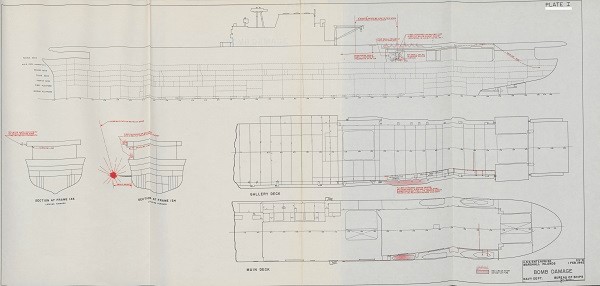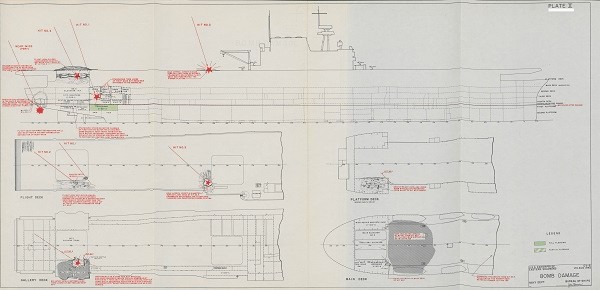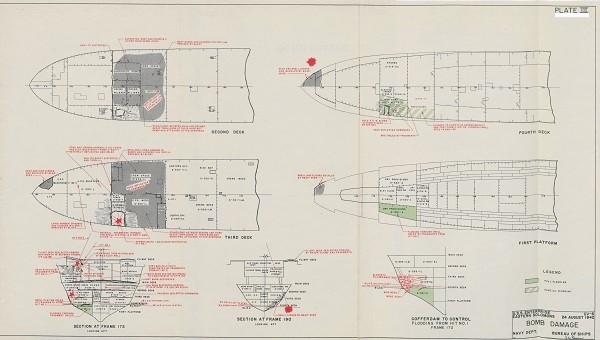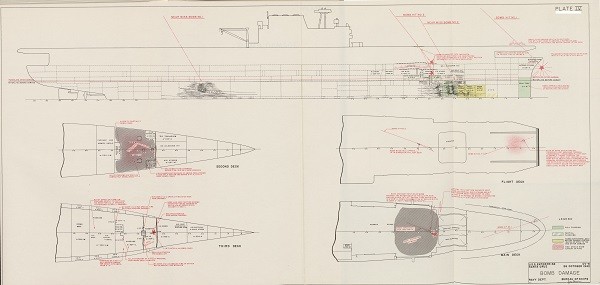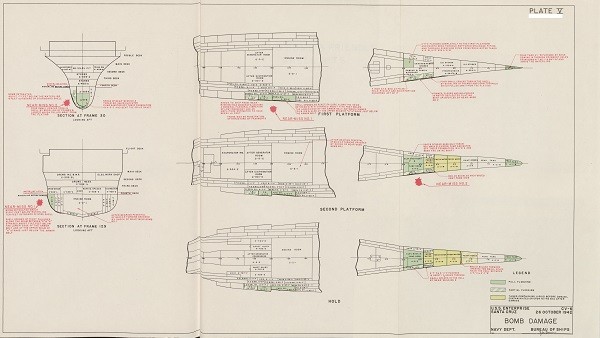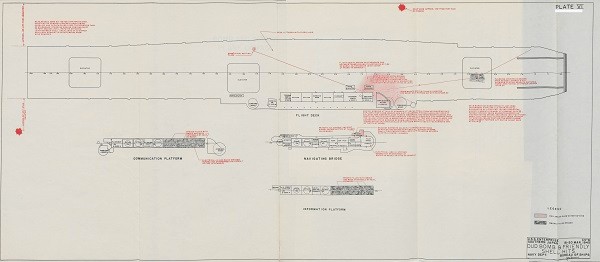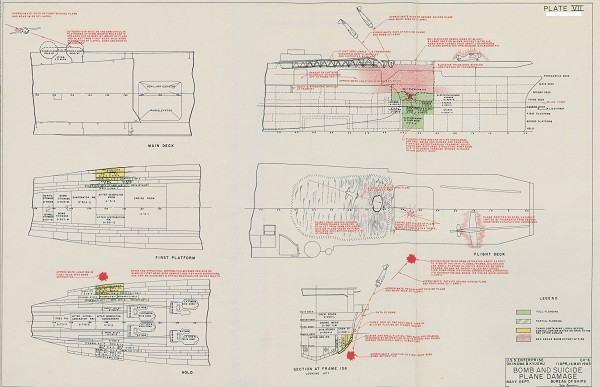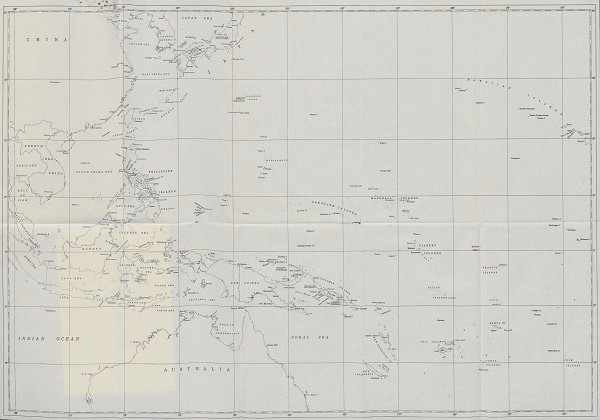
The Navy Department Library
USS Enterprise (CV6) War History
7 December, 1941 to 15 August, 1945
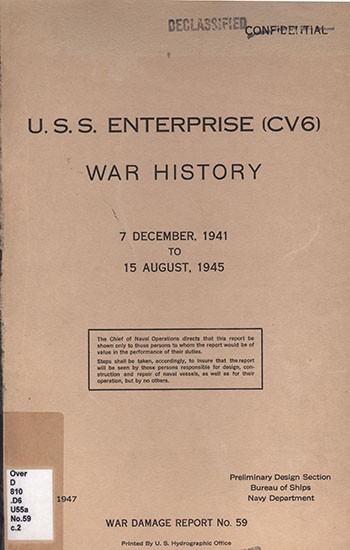
CONFIDENTIAL
U.S.S. Enterprise (CV6)
War History
7 December, 1941
to
15 August, 1945
War History
7 December, 1941
to
15 August, 1945
The Chief of Naval Operations directs that this report be shown only to those persons to whom the report would be of value in the performance of their duties.
Steps shall be taken accordingly to insure that the report will be seen by those persons responsible for design, construction and repair of naval vessels, as well as for their operation, but by no others.
Preliminary Design Section
Bureau of Ships
Navy Department
1947
War History
7 December 1941
to
15 August 1945
| Class | YORKTOWN (CV5 Class) | Length (O.A.) | 827 Ft. 4 In. |
| Launched | 3 October 1936 | Length (B.P.) | 770 Ft. 0 In. |
| Displacement (Standard) 19,900 tons (Before Blister Addition) |
Beam (Without Blisters) | 83 Ft. 1 In. | |
| Beam (With Blisters) | 95 Ft. 4-1/2 In. |
References:
General:
(a) War Diaries of ENTERPRISE, complete from April 1942 through September 1945, plus January 1942.
Damage of 1 February 1942:
(b) C.O. ENTERPRISE conf. ltr. to BuShips CV6/S81(50-wy), Serial 027 of 7 February 1942.
Damage of 24 August 1942:
(c) C.O. ENTERPRISE conf. ltr. to BuShips CV6/Lll-l(50-wy), Serial 0200 of 5 September 1942.
(d) Comdt. Navy Yard, Pearl Harbor, conf. ltr. to BuShips C-L11-1/CV/NY10, Serial Y-01967 of 25 October 1942.
(e) C.O. ENTERPRISE conf. ltr. to BuShips CV6/L9-3(50-B1), Serial 052 of 16 March 1943.
Damage of 26 October 1942:
(f) C.O. ENTERPRISE conf. ltr. to BuShips CV6/L11-1(50-B1), Serial 0273 of 8 November 1942.
(g) Comdt. Navy Yard, Pearl Harbor, conf. ltr. to BuShips C-L11-1/CV/ NY10, Serial Y-01420 of 14 July 1943.
Damage of 18 and 20 March 1945:
(h) C.O. ENTERPRISE conf. ltr. to BuShips CV6/Lll-l(50-cl), Serial 0200 of 4 April 1945.
Damage of 11 April 1945:
(i) C.O. ENTERPRISE conf. ltr. to Cominch CV6/A16-3(11-Pe), Serial 0208 of 16 April 1945.
(j) C.O. ENTERPRISE conf. ltr. to BuShips CV6/L9-3(70-Ec), Serial 0258 of 5 May 1945.
Damage of 14 May 1945:
(k) C.O. ENTERPRISE conf. ltr. to Cominch CV6/A16-3(ll-Pe), Serial 0273 of 22 May 1945.
(l) War Damage Report - U.S.S. ENTERPRISE - Actions of 11 April 1945 and 14 May 1945, prepared by Puget Sound Naval Shipyard and U.S.S. ENTERPRISE, forwarded by ComNavShipYdPug conf. ltr. to BuShips CV6/L11(254), Serial 0649 of 1 February 1946.
| SECTION | Page | |
| A | FOREWORD | 1 |
| Photographs Nos. A-1 to A-4 | ||
| B | EARLY HISTORY | 2 |
| 1. Design and Construction | 2 | |
| 2. Peacetime Operations | 2 | |
| 3. Start of the War | 3 | |
| C | BOMB DAMAGE, MARSHALL ISLANDS, 1 FEBRUARY 1942 | 4 |
| 1. Narrative | 4 | |
| 2. Material Damage | 4 | |
| 3. Fire and Firefighting | 5 | |
| 4. Conclusion | 5 | |
| Photographs Nos. C-1 and C-2 | ||
| Plate I | ||
| D | HISTORY, FIRST STRIKE AGAINST WAKE ISLAND, 24 FEBRUARY 1942, TO THE LANDINGS IN THE SOLOMONS, AUGUST 1942 | 6 |
| 1. Strikes Against Wake and Marcus Islands, | ||
| 24 February and 4 March | 6 | |
| 2. Bombing of Tokyo, 18 April | 6 | |
| 3. The Battle of Midway, 4-6 June | 6 | |
| 4. Landings on Tulagi and Guadalcanal, 7-9 August | 7 | |
| E | BOMB DAMAGE, BATTLE OF THE EASTERN SOLOMONS, 24 AUGUST 1942 | 8 |
| 1. Narrative | 8 | |
| 2. Damage and Damage Control Measures - Structural | 9 | |
| 3. Damage and Damage Control Measures - Piping, | ||
| Machinery and Electrical | 12 | |
| 4. Flooding and Flooding Control Measures | 13 | |
| 5. Fire and Firefighting | 14 | |
| 6. Japanese Bombs | 15 | |
| 7. Conclusion | 16 | |
| Photographs Nos. E-1 to E-20 | ||
| Plates II and III | ||
| F | BOMB DAMAGE, BATTLE OF SANTA CRUZ, 26 OCTOBER 1942 | 17 |
| 1. Narrative | 17 | |
| 2. Damage and Damage Control Measures - Structural | 18 | |
| 3. Damage and Damage Control Measures - Piping, | ||
| Machinery and Electrical | 21 | |
| 4. Flooding and Flooding Control Measures | 22 | |
| 5. Fire and Firefighting | 23 | |
| 6. Japanese Bombs | 24 | |
| 7. Conclusion | 24 | |
| Photographs Nos. F-1 to F-24 | ||
| Plates IV and V | ||
| G | HISTORY, 30 OCTOBER 1942 to 18 MARCH 1945 | 26 |
| 1. The Battle of Guadalcanal, 12-15 November 1942 | 26 | |
| 2. Winter and Spring 1943 | 26 | |
| 3. Overhaul, Summer 1943 | 27 | |
| 4. Amphibious Operations and Strikes, Winter 1943-44 | 28 | |
| 5. Spring Activities, 1944 | 28 | |
| 6. Advance to the Philippines, 1944-45 | 29 | |
| 7. Landings on Iwo Jima, February 1945 | 31 | |
| H | BOMB DAMAGE, STRIKES AGAINST SOUTHERN JAPAN, 18 and 20 MARCH 1945 | 33 |
| 1. Narrative | 33 | |
| 2. Dud Bomb of 18 March | 34 | |
| 3. Near-Misses, "Friendly" Shell Hits and Fire of 20 March | 34 | |
| Photographs Nos. H-1 to H-6 | ||
| Plate VI | ||
| I | SUICIDE PLANE CRASHES, OKINAWA, 11 APRIL 1945 | 37 |
| 1. Narrative | 37 | |
| 2. Damage and Damage Control Measures - Structural | 38 | |
| 3. Damage and Damage Control Measures - Piping, | 39 | |
| Machinery and Electrical | ||
| 4. Flooding and Flooding Control Measures | 41 | |
| 5. Fire and Firefighting | 41 | |
| 6. Japanese Planes and Bombs | 41 | |
| 7. Conclusion | 42 | |
| Photographs Nos. I-1 to I-10 | ||
| Plate VII | ||
| J | SUICIDE PLANE CRASH, KYUSHU, 14 MAY 1945 | 44 |
| 1. Narrative | 44 | |
| 2. Damage and Damage Control Measures -Structural | 45 | |
| 3. Damage and Damage Control Measures -Piping, Machinery and Electrical | 46 | |
| 4. Flooding and Flooding Control Measures | 49 | |
| 5. Fire and Firefighting | 49 | |
| 6. Japanese Planes and Bombs | 50 | |
|
7. Conclusion | 50 |
| Photographs Nos. J-1 to J-18 | ||
| Plate VII | ||
| K | EXIT ENTERPRISE | 52 |
| 1. Repairs | 52 | |
| 2. The "Magic Carpet" | 52 | |
| 3. A National Memorial | 52 | |
| L | SUMMARY AND CONCLUSION | 53 |
| 1. Summary | 53 | |
| 2. Conclusion | 55 |

1. BOMB DAMAGE, MARSHALL ISLANDS, 1 FEBRUARY 1942
2. BOMB DAMAGE, BATTLE OF THE EASTERN SOLOMONS, 24 AUGUST 1942
3. BOMB DAMAGE, BATTLE OF SANTA CRUZ, 26 OCTOBER 1942
4. BOMB DAMAGE, STRIKES AGAINST SOUTHERN JAPAN, 18 AND 20 MARCH 1945
5. SUICIDE PLANE CRASHES, OKINAWA, 11 APRIL 1945
6. SUICIDE PLANE CRASH, KYUSHU, 14 MAY 1945*
A-1. The war history of ENTERPRISE is unique in length of active service, in extent of destruction brought to the enemy and in number of instances of damage survived. Therefore, this war damage report has been written with brief summaries of operational history and detailed discussions of each instance of damage to cover the whole war experience of the ship.
A-2. ENTERPRISE served with the Fleet throughout the war, steaming more than 275,000 miles and accumulating 18 out of a possible 22 combat stars for carriers in the Pacific area. She missed only the Battle of the Coral Sea and three operations in the Southwest Pacific: Eastern New Guinea, Bismarck Archipelago and Treasury-Bougainville Island.
A-3. Her planes, the "big guns" of a carrier, are credited with sinking or an assist in the sinking of 71 enemy ships and with damaging 192 enemy ships. The sinkings and assists include three large carriers and a heavy cruiser of the Japanese Fleet in the Battle of Midway and a battleship, large cruiser and four carriers in the Battle for Leyte Gulf.
A-4. During the period of the war she was damaged by the enemy on six separate occasions by 13 hits or near-misses from bombs or suicide planes. In addition, she was damaged by a fire caused by the detonation of a "friendly" 5-inch anti-aircraft shell. In all cases but one, her excellent damage control organization prevented serious consequences and enabled ENTERPRISE to continue in action. Damage to her flight deck which resulted from the suicide plane crash of 14 May 1945 so impaired her operating efficiency that she was forced to retire the following day.
___________
*Solid line indicates hits
Dashed lines indicate near-misses
+"Friendly" shell hits
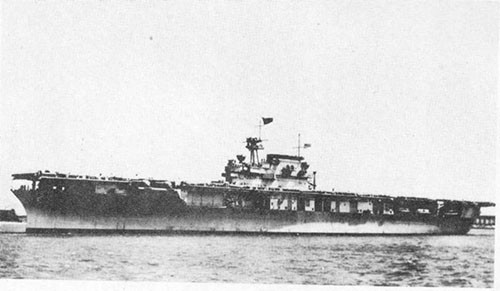
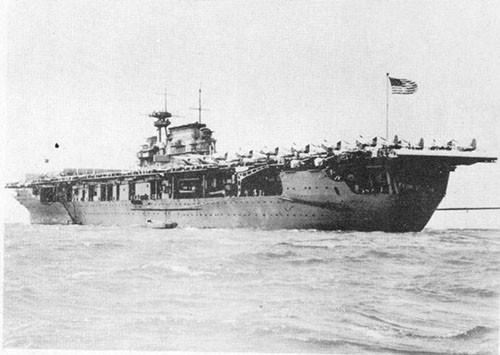
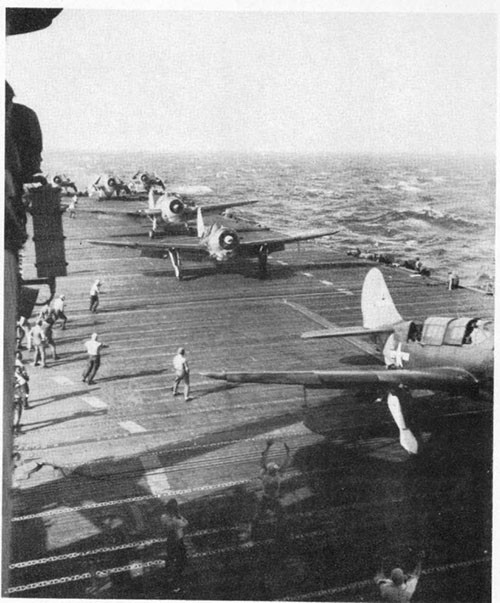
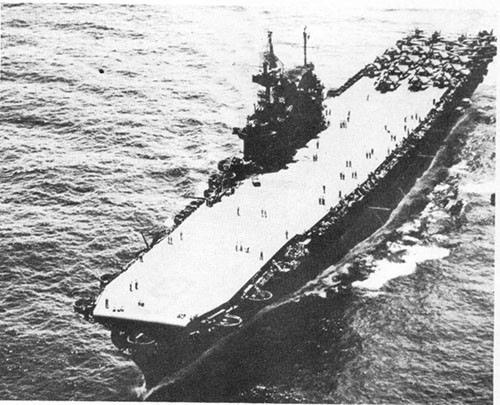
B1-1. At the close of World War I the potentialities of Naval air-power were recognized and in order to initiate development of a sound doctrine the collier JUPITER was converted into the experimental aircraft carrier LANGLEY (CV1). She was followed in 1927 by LEXINGTON (CV2) and SARATOGA (CV3), which were converted from battle-cruisers as a result of the Washington Treaty for the Limitation of Naval Armament.
B1-2. Through the years 1922 to 1929 preliminary design studies of 10,000, 13,800, 17,230 and 23,000 ton standard displacement aircraft carriers were made in order to determine the best way to utilize the 69,000 tons of carriers allowed under the Washington Treaty. Problems of suitable speed, armor, armament, torpedo protection, disposition of flue gases, arrangement of flight decks, elevators and hangars, location of bridge, criteria of stability, etc. were studied by the Bureau of Construction and Repair and discussed with the General Board, other Bureaus of the Navy Department and operating personnel. The studies finally crystallized into plans for RANGER (CV4), the first U.S. aircraft carrier to be designed as such from its inception. RANGER was ordered 1 November 1930 and commissioned 4 June 1934.
B1-3. With a valuable background of design lessons derived in the development of RANGER and a much greater knowledge of carrier operations gained from experience with LANGLEY, LEXINGTON and SARATOGA, preliminary design work on ENTERPRISE was started in 1931. Displacement was increased from 14,500 to 19,900 tons standard and speed from 29.5 to 32.5 knots. Many significant changes were made in the arrangements so that ENTERPRISE and her sistership, YORKTOWN (CV5), embodied many advances in carrier development. Construction of ENTERPRISE was ordered 3 August 1933 and her keel was laid 16 July 1934 at Newport News Shipbuilding and Dry Dock Company. She was launched 3 October 1936 and commissioned 12 May 1938.
B2-1. After a shakedown cruise to Brazil and winter maneuvers with the Fleet in the Caribbean early in 1939, ENTERPRISE was ordered to the Pacific in April 1939. With the proclamation of a state of limited national emergency in September 1939, she proceeded to Pearl Harbor where she trained for war operations as a part of the Hawaiian Fleet Detachment and shuttled planes and squadrons among the Pacific island bases. On 28 November 1941 she departed Pearl Harbor for Wake Island with twelve Marine Corps fighter planes to be delivered to the newly completed airfield there.
B3-1. ENTERPRISE was scheduled to return to Pearl Harbor on 6 December, but fortunately was delayed a day by heavy weather. Some of her planes flew to Pearl Harbor during the Japanese raid on 7 December and the remainder were launched in an unsuccessful attempt to locate the enemy carriers after word of the attack on Pearl Harbor had been received by radio. During the early weeks of the war she patrolled to the west of the Hawaiian Islands and acted as escort for transports reinforcing Samoa. Later in January she sailed north to participate in the first offensive U.S. carrier action of the war - the strike against the Marshall and Gilbert Islands on 1 February. There, ENTERPRISE with one task group of cruisers and destroyers and YORKTOWN with another participated in a joint air and sea bombardment.
B3-2. Planes from ENTERPRISE bombed and strafed shore installations on Moloelap, Wotje and Kwajalein in the Marshalls, and bombed and torpedoed several enemy ships including one cruiser and two submarines. The raid set back Japanese plans for strengthening bases in the West Central Pacific, and provided the first good news after the disaster at Pearl Harbor. The opposite result might have occurred if ENTERPRISE had not successfully evaded two determined bombing attacks from Japanese land-based planes, receiving only minor damage from a near-miss.

C1-1. About. 1340 on 1 February 1942 while operating in the northeastern Marshalls, ENTERPRISE was approached on the starboard bow by five Japanese twin-engined land planes flying at 10,000 feet. While in a shallow power dive to about 3,500 feet, each plane released three bombs. ENTERPRISE was maneuvering at high speed and all bombs fell beyond the ship, the nearest about 50 feet off the port quarter at frame 130. The bombs were estimated by the ship to be general purpose with instantaneous fuzes, weighing between 100 and 200 pounds and were probably the 63 Kg Type 99 No. 6 Ordinary type (U.S. Navy Bomb Disposal School designation 63 Kg SAP). This bomb corresponds in size and charge weight approximately with the U.S. 100-pound GP type, but has somewhat superior penetrating ability.** Splashes were 100 to 125 feet high. Slight shock was felt throughout the ship, similar to that caused by firing the ship's guns. Fragments struck the port quarter.
C1-2. One plane returned, apparently to strafe the ship. Its right wing scraped the flight deck between frames 74 and 65, knocking off the ship's port side light and cutting off the tail of a scout bomber on deck. It plunged over the port side at frame 62 and carried away the forward stay of the antenna outrigger.
C1-3. A second attack began at 1600, when two Japanese twin-engined planes each dropped two bombs off the starboard bow. The nearest was 150 yards away and the splashes appeared to rise higher than those of the first bombs. Although several fragments were found on the forecastle, no damage was incurred.
C2-1. Fragments from the first attack opened four 1/2-inch holes in the 1/4-inch medium steel plating of the port hangar bulkhead between frames 130 and 133 and six holes in the hangar roller curtain (Plate I). There were numerous dents in the 5/8-inch STS shell plating below the main deck and fragments pierced and dented the splinter mats, gallery walkway, ladders and gallery deck in way of the .50 cal. machine gun at frame 134.
____________
* BuShips War Damage Report No. 5
** Handbook of Japanese Explosive Ordnance, OPNAV 30-3M, 15 August 1945
C2-2. The externally-fitted 2 to 2-1/2-inch gasoline line was pierced by fragments in nine places between frames 119 and 135. A gasoline fire resulted.
C2-3. The M-1, M-2 and M-6 coils of the externally-fitted degaussing cable at frame 126, the hangar sprinkler electrical control box in the port pocket at frame 133 and fifteen minor electrical cables were pierced or severed by fragments or destroyed in the gasoline fire.
C3-1. Gasoline from the pierced gasoline line caught fire either from hot fragments or electrical short circuits and the fire spread over the port gallery walkway and the boat pocket between frames 130 and 144. The flames consumed canvas covers, splinter mats, airplane fueling hose, rubber deck matting, life jackets and paint on the deck and bulkheads (Photos C-1 and C-2).
C3-2. Although the fire seemed very threatening, it was soon extinguished with chemical foam from pressure-operated foam generators (phomene accumulators).
C4-1. By quick and effective use of the available firefighting apparatus, ENTERPRISE repair parties successfully passed their first real test.
C4-2. The penetration of splinter mats by fragments substantiated the prior decision to discontinue their use because of their limited value against even low velocity fragments.
C4-3. Although a gasoline fire developed as a result of penetration of the exposed portion of the gasoline piping by fragments, no change in its location was seriously considered. It would be impracticable to give adequate protection to this main and a fire on the gallery walkway is obviously preferable to one in the hangar.
C4-4. Although internal fitting of degaussing cables had become standard practice, ENTERPRISE could not be so fitted until her extensive 1943 overhaul.
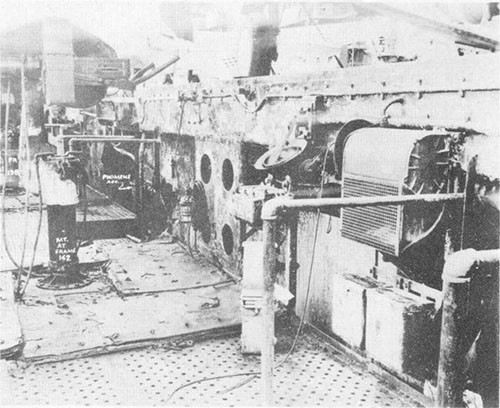
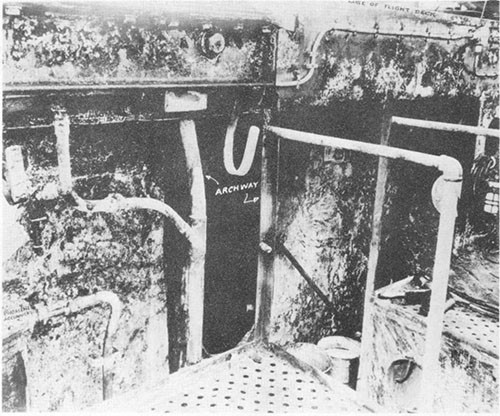
HISTORY
FIRST STRIKE AGAINST WAKE ISLAND, 24 FEBRUARY 1942 TO THE LANDINGS IN THE SOLOMONS, AUGUST 1942
1. Strikes Against Wake and Marcus Islands, 24 February and 4 March
D1-1. After the success of the raid on the Marshalls, other strikes were planned. While one task force assembled around LEXINGTON made a diversionary attack on Rabaul, ENTERPRISE accompanied another force against the newly established enemy garrison on Wake Island. Extensive damage to shore installations was inflicted by a combined air-sea bombardment.
D1-2. A brief surprise attack was next made on Marcus Island. Planes bombed shore installations before dawn and then returned to ENTERPRISE which was already proceeding toward Pearl Harbor.
D1-3. During March, alterations, including removal of ten boats and most of the .50 cal. machine guns and the installation of thirty 20mm guns and additional radar units, were accomplished by Navy Yard, Pearl Harbor.
D2-1. On 8 April, ENTERPRISE and her escort departed Pearl Harbor to rendezvous with HORNET (CV8) which had sailed from San Francisco with 16 Army B-25's spotted on her flight deck, destined for a bombing raid on Tokyo. ENTERPRISE provided search and combat air patrol for the attack on the Japanese capital. Although the force encountered heavy gales and was discovered some 800 miles off the coast of Japan, the bombers got away and were successful in carrying out their mission. The ships returned to Pearl Harbor on 25 April.
D3-1. ENTERPRISE next headed south to assist LEXINGTON and YORKTOWN in their efforts to slow the advance of the Japanese, but arrived too late to take part in the attack on the Japanese force at Tulagi, 4 May, and the air battles (Battle of the Coral Sea), 7 and 8 May, in which LEXINGTON* was sunk and YORKTOWN** was damaged. She returned to Pearl Harbor just in time to depart again to repel the expected Japanese landings on Midway.
D3-2. The Battle of Midway was a turning point in the Pacific War, for from this time the balance of power in the Pacific shifted steadily to the United States side. Three large forces of Japanese ships,
___________
* BuShips War Damage Report No. 16
** BuShips War Damage Report No. 23
including many transports and cargo vessels, supported by seven carriers, eleven battleships, about fourteen cruisers and many destroyers were severely mauled and driven off by U.S. air groups from two task groups built around ENTERPRISE, HORNET and YORKTOWN and by land-based bombers. The Japanese were completely surprised. Four carriers and one heavy cruiser were sunk and one heavy cruiser, two destroyers and one transport were damaged. On 4 June dive bombers from ENTERPRISE and HORNET severely damaged the four carriers which later sank, and sank the heavy cruiser on 6 June. One of the damaged carriers was torpedoed by a submarine and sank, one sank as the result of a delayed fuel tank explosion and the other two were scuttled by their crews on 5 June. ENTERPRISE was not damaged, but YORKTOWN* and HAMMANN (DD412) were lost.
D4-1. Following Midway, ENTERPRISE had a short availability at Pearl Harbor, during which the forward auxiliary elevator, the two catapults on the main deck and the remaining .50 cal. machine guns were removed. A 1.1-inch anti-aircraft mount was added at the extreme bow on the forecastle deck and forward fire control radar installed.
D4-2. ENTERPRISE departed 15 July for Tongatabu, the staging area for the landing in the Solomons. To cover the amphibious force and fire support groups of the first U.S. offensive thrust, three task groups were formed around SARATOGA, WASP (CV7) and ENTERPRISE. During the successful landings of 7 August on Tulagi and Guadalcanal, planes from the carriers provided air reconnaissance and tactical bombing. They were unable to participate, however, in the surprise night engagement of 8-9 August fought off Savo Island during which three U.S. cruisers were lost.
___________
* BuShips War Damage Report No. 25
BOMB DAMAGE
BATTLE OF THE EASTERN SOLOMONS, 24 AUGUST 1942

1. 250 KG. BOMB HIT, FRAME 174
2. 250 KG. BOMB HIT, FRAME 179
3. 250KG. BOMB HIT, FRAME 127
4. NEAR-MISS 250KG. BOMB, FRAME 193 PORT
E1-1. During the two weeks following the landings in the lower Solomons, the three carrier task groups operated to the southeast of Guadalcanal. On 23 August, WASP's task group was detached, leaving SARATOGA and ENTERPRISE in the area. The following day air contact was made with a large Japanese force of combatant ships. Planes from our carriers attacked this force at the same time our carriers were being attacked by Japanese planes. A Japanese carrier, a destroyer and a transport were sunk; 90 enemy planes were destroyed; a small carrier and a light cruiser were damaged. The Japanese retired without a surface engagement being joined. ENTERPRISE was the only U.S. vessel damaged.
E1-2. About 1712 on 24 August, ENTERPRISE underwent a heavy five-minute attack from more than 30 Japanese dive-bombers during which she received three direct bomb hits and four near-misses. The first bomb struck about two minutes after the start of the attack piercing No. 3 elevator at the flight deck and detonating 42 feet below, between the second and third decks, close to the starboard side. It caused extensive, though not serious structural damage, minor flooding, disablement of No. 3 elevator and several stubborn fires. Half a minute later a second bomb struck the flight deck at frame 179, close to the starboard edge of the same elevator, detonating 8 feet below. The flight deck was deflected upward and a severe fire broke out as 40 rounds of 5-inch 38 cal. propellant powder were ignited. A third bomb, dropped a minute later, detonated on impact with the flight deck near the after starboard corner of No. 2 elevator, putting the elevator out of commission and starting a small fire. At 1717 a bomb detonated in the water about 12 feet off the port quarter, causing general flexural vibration of the ship and permanent deformation of the hull and several decks, including the flight deck. Three other near-misses, which caused minor fragment damage, occurred during the attack.
E1-3. Despite the damage, ENTERPRISE commenced landing planes within an hour after the engagement. The following day, however, she proceeded to Pearl Harbor for repairs, escorted by PORTLAND (CA33) and four destroyers.
E2-1. The first bomb, released from a 65° or 70° dive at an altitude of about 1500 feet, penetrated the forward starboard corner of No. 3 elevator at frame 174, 22 feet to starboard of the centerline. Leaving only a small hole, it continued down through the starboard bulkhead of the elevator well, the inboard forward corner of the GROUP III gun gallery, the hatchway on the flat below, the hangar deck at frame 172 and the second deck in D-203-1LM to its point of detonation between the second and third decks in D-303-1L at frame 171, 12 feet from the starboard side. Total thickness of steel plating penetrated was 2 inches including 1/4 inch of STS and distance from point of impact to point of detonation was 42 feet (Photos E-1, E-2 and E-3).
E2-2. The bomb detonated high order. Its blast tore large holes in the second and third decks, a 12-foot by 4-foot hole in the fourth deck, and a 6-foot by 2-foot hole through the side plating (Photos E-4, E-5 and E-6). The second deck was bulged up 4 to 12 inches over its entire width between frames 157 and 173 and the third deck was dished down more or less irregularly over the same area (Photos E-8 and E-9). The main deck was bulged up symmetrically between frames 157 and 173 between the port and starboard boat pockets to a maximum height of 16 inches at frame 165. Stanchions between the main and second, and second and third decks were torn loose at their base but remained attached to the overhead (Photo E-9). The fourth deck was dished down in D-419-3A from the starboard shell to the inboard bulkhead. Transverse bulkheads 157 and 173 were only slightly distorted, except above the third deck immediately adjacent to the detonation where bulkhead 173 was badly distorted and torn. The starboard bulkhead around hydraulic oil tank and elevator machinery trunk, D-523-T, was severely deflected and holed above the third deck (Photo E-7) and deflected between the third and fourth decks. Watertight doors 2-173-1, 3-157-1, 3-173-1 and 3-186-2 were blown open and wrecked. Nearly all bunks and lockers in D-203-1LM, D-303-1L and D-305-L were demolished. The crew's washroom, D-203-2L, the carpenter shop and the brig were wrecked. Numerous longitudinals, frames and vertical stiffeners were severed, cracked or buckled.
E2-3. Fragment damage was extensive. Stiffeners, cables, ducts and piping under the main deck above the explosion were riddled, though only a few fragments perforated the deck itself (Photos E-4 and E-5). The second deck was peppered with holes and the third and fourth decks were also penetrated. A few fragments pierced the shell plating in D-305-L, D-303-1L, D-419-3A and D-521-A (Photo E-6). Other fragments passed through bulkhead 157 above the third deck, through bulkhead 165 into D-417-A, and through the starboard bulkhead of D-523-E. The maximum distance traveled by a fragment was 56 feet after which it pierced the 3/8-inch medium steel plate of bulkhead 157 above the third deck. The maximum thickness of plating penetrated was the 5/8-inch medium steel shell plating below the fourth deck, at a distance of 16 feet.
E2-4. The second bomb, released at about the same height and angle as the first, pierced the flight deck at frame 179 about 11 feet from the starboard edge of that deck and close to the starboard edge of No. 3 elevator. It traveled about 8 feet and detonated high order about 3 feet
above the deck of the GROUP III gun gallery, slightly forward and outboard of the point of impact (Photos E-11, E-12 and E-13).
E2-5. The blast tore a 12-foot by 6-foot hole in the adjacent starboard bulkhead of No.3 elevator trunk and another about 18 feet by 8 feet in the gallery deck (Photos E-15 and E-16). Instruments on 5-inch guns Nos. 5 and 7 were wrecked and the guns rendered unsafe for use. The ammunition hoist for No. 7 gun was torn loose and pushed inboard and the scuttle completely destroyed. The hoist for No. 5 gun was damaged and disabled. The splinter shield between the guns was torn loose at the bottom and bent aft (Photo E-14) and the sponson shield for No. 5 gun was blown out. The ready service powder locker for gun No. 5 was demolished and blown inboard and approximately 40 rounds of 5-inch propellant powder were destroyed by burning. Although the ready service locker for No. 7 gun also was distorted, the powder in it did not ignite. Hatch and scuttle 02-174-1 were blown in and wrecked and the upper half of door 1-174-1 was blown off and twisted. The flight deck above the gun gallery was deflected upward a maximum of 18 inches between frames 173 and 186 (Photo E-12). No. 2 arresting gear deck sheave was loosened and the yielding element control cable cut.
E2-6. Fragment attack was less severe than from the first hit. Fragments traveled downward through the deck of the gun gallery, the platform deck in the ready airplane issue room D-103-A, the main deck in D-103-A and upward through the flight deck. The splinter shields and guns Nos. 5 and 7 were peppered with small fragments and other fragments perforated the starboard bulkhead of No. 3 elevator trunk and the starboard bulkhead of D-102-E. The maximum distance traveled by a fragment was about 50 feet after which it penetrated 1/4-inch medium steel plate. The maximum thickness of plating pierced was that of the 3/4-inch STS main deck at a distance of about 19 feet.
E2-7. The third bomb, released from a 60° dive at an altitude of about 1500 feet, struck the flight deck at frame 127, 28 feet to starboard of the centerline, close to the starboard after corner of No. 2 elevator and detonated instantly (Photo E-18). Portions of the nose continued down through hatch cover 2-119 and trunk C-408-1A as far as the fourth deck.
E2-8. A hole approximately 10 feet in diameter was blown in the flight deck by the detonation (Photos E-17 and E-18). Blast knocked a high pressure torpedo charging flask from its bracket on the hangar deck bulkhead, but did not damage it. The yielding element of No. 9 arresting gear was blown overboard.
E2-9. Fragments cut or damaged the purchase cable sheave bracket, purchase cable, yielding element control cable and barrier cross-deck cable of No. 9 arresting gear and the purchase cables of Nos. 7 and 8 arresting gears. Fragments also pierced hatch cover 03-107, elements of No. 2 crane, the overhead of C-0211-A, the flight and hangar decks and one continued through the second deck. Although the bomb detonated almost against 3/4-inch STS plating protecting the ready torpedo and warhead stowage, no fragments penetrated. Yet the 3/4-inch STS after bulkhead of C-0301-M was pierced at a distance of 68 feet. The maximum distance traveled by a fragment was 113 feet after which it pierced 1/8-inch medium steel plating.
E2-10. While the ship was heeled to starboard in a left turn, a bomb detonated abreast frame 193 about 12 feet from the ship's port side. It had been released on the starboard quarter at a low angle of dive, about 50°, and at an altitude of about 1000 feet. The detonation caused general flexural vibration of the ship of low frequency but of relatively high amplitude. The Commanding Officer estimated that the stern was lifted bodily 2 or 3 feet.
E2-11. The column of water thrown up by the detonation deformed the flight deck upward about 8 inches between frames 194-1/2 and 198 for 17 feet inboard of the port waterway (Photo E-20). Four of the flight deck longitudinals were bent and two broken, planking in the area was split and shredded and a 60-man life raft secured at the gallery level on the port side was completely demolished. The force of the detonation dished in the hull between frames 188 and 196 from the first platform to the main deck (Photo E-19). The hangar deck was bulged upward slightly over a radius of 5 feet at frame 192 port, the second deck was buckled upward about 2 inches between frames 192 and 193-1/2 for about 3 feet inboard of the shell, third deck plating was wrinkled throughout the after CPO washroom and fourth deck plating was wrinkled 10 feet inboard of the shell. Bulkheads 190-1/2 and 192 were wrinkled 5 feet inboard. Below the fourth deck, in the void spaces, floors were buckled from the stern to as far forward as frame 188 and frames 189 through 195 were variously bent or broken.
E2-12. Two other confirmed near-miss bombs which detonated abreast frames 70 and 100 on the port side caused minor fragment damage on the port side between frames 78 and 93.
E2-13. The structural damage caused by the hits and near-misses did not seriously reduce the strength of the ship girder, but impeded operations. The large hole in the flight deck resulting from the detonation of the third bomb was rapidly covered with two 6-foot by 9-foot, 3/8-inch plates which were secured to the wood deck around the hole by 60 penny nails, previously cut short to a length of 2-1/2 inches. Nail holes had previously been drilled in the plate edges at 6-inch intervals. An identical plate was used to cover the hole in No. 3 elevator. Pieces of 1/8-inch plate 24 inches by 12 inches or 18 inches square were secured in a similar manner over small fragment holes. These repairs were evidently effective, for, within an hour, planes were landing on the deck.
E2-14. Wooden shores were fitted to support the main and second decks in way of ruptured stanchions, but vibrations at high speeds loosened the shores, so the stanchions were partially re-established by welding patches over the holes torn in the deck and four short lengths of 3-inch by 3-inch by 3/8-inch angle to each stanchion and to the patched deck (Photo E-9). Deck longitudinals broken at their connections to deck beams were temporarily strengthened by welding short sections of 2-1/2-inch by 2-1/2-inch angle to the beam, the longitudinal and the overhead. Where the deck had been pulled away around sounding tubes, split collars were fitted and welded to the deck and pipe.
E3-1. The principal machinery damage caused by the first hit was disablement of machinery of No. 3 elevator which put the elevator out of commission. Both the low and the high pressure accumulator tanks were forced away from the starboard bulkhead in D-523-E, the oil storage tank was crushed and the bottom blown out, and motors were submerged in oil and salt water. This was a serious casualty, its repair beyond the capacity of the ship's force. However, since the elevator was at the flight deck level, flight operations were able to continue.
E3-2. Ammunition hoist motor No. 8 in D-203-1LM was knocked from its mounting and hoists in D-203-1L and D-303-1LM were bent and inoperable. Ventilation blowers 2-158-1, 2-158-2, 2-170, 2-176-1 and 4-173-4 were wrecked and ventilation ducts in the damaged spaces rendered useless. The aftermost riser of the firemain at frame 173 was ruptured in several places, but with the firemain split into four sections, each with its own pump, this casualty was easily isolated. The starboard riser for the hangar deck water curtain in bay No. 4, frame 173, was ruptured eight feet above the main deck and damage control mains in the damaged compartments were ruptured or carried away. Numerous lighting cables were cut in the damaged spaces.
E3-3. The second bomb completed the disablement of No. 3 elevator. Fragments gouged and burred the main plungers, destroyed the elevator platform lock, carried away all electrical leads and extensively damaged the flight deck safety rail and its starboard control shaft.
E3-4. All power wiring, fire control wiring, I.C. wiring and lighting in GROUP III gun gallery were completely destroyed. The motor and solenoid for controlling closure of the vent cover on the steering engine room exhaust duct were demolished. Machinery in the aviation sheet metal shop was damaged.
E3-5. An hour and a half after the second bomb hit and as a secondary result thereof, the casualty occurred which, from an operational standpoint, was the most serious of the whole engagement. ENTERPRISE was retiring south from the battle with the rest of the task force at 24 knots functioning again almost normally and landing aircraft when, suddenly, the rudder went hard left, then hard right and finally stopped at 20° right. Water and foamite used to fight the fire caused by the second bomb had collected in the exhaust vent trunk leading directly from the two steering motor casings in steering motor and control room (D-524-E) to the gun gallery. This trunk, holed by the first bomb at the level of the gun gallery, had been closed off immediately at its lower end and the exhaust fan secured when smoke and water passed down the duct. Supply blower 4-173-4 had been disabled by the first hit, cutting off the supply of air to the space; so, conditions became almost unbearable for personnel. When the ventilation system was reopened, water and foamite poured from the exhaust duct, flooded the starboard steering motor and its control panel and stopped the motor. Exhausted by heat
and smoke, personnel on watch could not shift to the undamaged port motor before collapsing and the rudder stopped as noted above. A rescue party made its way to the space and put the port motor in operation restoring steering 38 minutes after it had been lost.
E3-6. The third bomb disabled No. 2 elevator leaving only No. 1 elevator able to handle aircraft. The platform lock control shaft, including the bevel gears, was carried away for about 15 feet along the starboard after side of the transverse hatch girder, the flight deck safety rail and two stanchions were badly damaged, hydraulic and air lines to the main elevator platform lock power unit were ruptured or crushed, and elevator control cables and electrical leads to the after safety rail control motor were carried away. Both elevator plungers were scored and burred by fragments, the largest score being 1-1/2 inches long by 3/32 inches deep in the forward plunger. The adjacent torpedo elevator was also rendered inoperable. Repair of this damage was beyond the capacity of the ship's force.
E3-7. The near-miss on the port quarter caused considerable leakage through the stern tube glands of Nos. 2 and 3 shafts. Two blades of No. 2 propeller and all three blades of No. 3 propeller had edges curled aft by the detonation. Degaussing cable "Q," and "M" coils, fitted externally on the sheer strake, were torn loose from their supports for a length of 30 feet on the port quarter, but were not broken.
E3-8. Fragments from the other near-misses punctured the "M" and "F" degaussing coils in numerous places in way of frame 80 port and starboard, pierced sections of the gasoline line at hangar and flight deck levels between frames 80 and 106 port, and carried away the auxiliary radio antenna on the port side at frame 80.
E4-1. The shell was opened in way of the waterline by the detonation and fragments from the first bomb hit. As a result, D-521-A was completely flooded and D-419-3A partially flooded. A small hole in the forward bulkhead of D-419-3A permitted D-417-A to flood to a depth of about one foot on the starboard side. The addition of this water caused a list of approximately 3° to starboard. Trim aft was increased by 11 inches. The increase of mean draft was negligible.
| Drafts: | Forward | Aft |
| Before damage: | 24 feet 0 inches | 27 feet 8 inches |
| After damage: | 23 feet 7 inches | 28 feet 2 inches |
These drafts do not quite check with the ship's estimate of 245 tons of flooding water, but may have been incorrectly read.
E4-2. Measures were taken immediately to remove the list by pumping out approximately 10,000 gallons (38 tons) of sea water from each of the following starboard tanks: B-15-F, B-21-F and B-27-F; and flooding the following port tanks with 10,000 gallons each: B-16-V, B-22-V and B-28-V. Spaces adjacent D-521-3A were found to be tight so the outboard bulkheads of D-520-A and D-523-E were shored. Flooding through the holes in D-521-A and D-419-A was stopped by constructing a cofferdam between frames 169 and 173, from the third deck down to the shell. The cofferdam was constructed of 2-inch by 6-inch planking set vertically into slots formed between 3-inch by 6-inch by 18-foot planks laid on the third and fourth decks (Plate III). Wire mesh was laid over the large hole and mattresses, blankets and pillows were packed down between the shell and the cofferdam, which was then wedged outboard, forcing the packing materials tight against the hull (Photo E-5). Flooding through a smaller hole, about 12 inches by 18 inches, just below the large hole, was stopped with an 18-inch wooden plug cut to shape. Smaller wooden plugs were forced into the little fragment holes. Although a speed of 25 knots and many course changes made construction very difficult, the cofferdam was completed in eighteen hours. Air-driven submersible pumps were used for initial pumping down of the flooded compartments and electric submersible pumps were added later. It took five pumps about six hours to dewater the two spaces because debris continually clogged the strainers. After the compartments were pumped down, only one submersible pump running ten minutes an hour was required to take care of the seepage through the cofferdam into D-521-A.
E5-1. The first bomb started a smoldering fire in protective clothing and gas masks in GROUP III 5-inch gun gallery as it passed through. This fire was absorbed in the general conflagration on the gallery deck which resulted from the second hit.
E5-2. Detonation and fragments from the first bomb started a serious Class A fire in bedding and personal effects in living compartments D-203-1LM, D-303-1L and D-305-L. Dense smoke completely filled these compartments. There was little paint on bulkheads and overheads to support the conflagration.
E5-3. Dense smoke, wreckage and damage to the firemain hindered firefighting personnel. The ventilation supply system was started in the undamaged area forward on the second and third decks, portable ventilation sets were set up and doors and hatches were opened to the hangar deck in an effort to clear the smoke and give access to the firefighters. Gas masks were found to give relief from the smoke for short periods. At first, firemain valves 5-160-5 and 5-125-3 were closed to segregate the damaged section, but when the damage was found to be in the riser aft of frame 160, valve 5-125-3 was opened. Before the damaged main was segregated, water pouring from the riser helped to extinguish the hottest fire in D-303-1L near the point of detonation. Damage control valve 7-129 was closed to prevent flooding from broken damage control mains and risers, but was reopened and valve 6-143-5 closed when damage was found to be confined to the starboard side. The fire was brought under control in an hour.
E5-4. Detonation of the second bomb in the gun gallery caused, the immediate ignition of about 40 rounds of 5-inch 38 cal. ready service powder. Heavy weather and protective clothing, gas masks, rubber matting on the deck and paint on the guns contributed additional combustible material. Since all personnel in the gun gallery were killed, the fire was fought by repair parties from the flight deck (Photo E-11). Water, foam and CO2 were used to bring this fire under control in about 40 minutes. As soon as conditions permitted, all remaining powder and projectiles from the gallery were jettisoned. The fire spread from the blasted gun gallery to airplane accessories, flight clothing, rubber lungs, etc. in airplane issue room D-103-A immediately below. This fire smoldered and broke out periodically for eight hours. In D-103-E minor fires occurred and were quickly extinguished among rubber hose, bedding, electric cables, in the paint on the overhead and in some small pieces of wood in the port forward corner of the elevator pit.
E5-5. A small fire, which was extinguished by water and CO2, was ignited in the port after corner of C-0211-A by fragments from the third bomb detonation.
E6-1. The Commanding Officer estimated the hits to be from bombs as follows:
| Weight in Pounds |
Diameter | Kind | Impact to Detonation |
Detonation | Fragments Recovered |
Smoke | |
| 1st Hit | 1000 | 12 In. | AP | 42 Ft. | High Order | 1 In. | Yellowish |
| 2nd Hit | 500 | 12 In. | GP | 8 Ft. | High Order | 1 In. | Not Noxious |
| 3rd Hit | 500 | ? | ? | 0 | Low Order | 10 In. Nose | White |
| Near-Miss on Port Quarter | 500-1000 | ? | ? | ? | High Order | None | None |
E6-2. The holes left by the first bomb as it passed through the elevator and main deck indicate that the diameter was approximately 12 inches (Photos E-1 and E-2). Therefore, this bomb was probably a 250 Kg Type 99, No. 25 Ordinary bomb (U.S. Navy Bomb Disposal School designation 250 Kg SAP) which corresponds approximately in size and charge weight with the U.S. 500-pound GP bomb. The extent of damage was consistent with the amount of explosive carried in a 250 Kg bomb and fragmentation was exceptionally good.
E6-3. From the small amount of evidence available, it is estimated that the second hit and the severe near-miss under the port quarter were also 250 Kg Ordinary bombs. The second bomb detonated in an unconfined space which would account for the lesser damage as compared with that of the first bomb.
E6-4. The comparatively light damage and the recovery of large fragments, some 10 inches in diameter, and segments of the nose of the third bomb indicate that it detonated low order. It, too, was probably a 250 Kg Ordinary bomb.
E7-1. The campaign to scrape all paint from bulkheads, overheads and decks inside the ship, which was almost completed in the section affected by the first hit, reduced the extent of the fires. Dispersal of repair party personnel and equipment and detailing special firefighters to operate CO2 systems in paint, alcohol and pyrotechnic lockers led to prompt action in combatting fires and repairing damage. The skill shown by personnel of ENTERPRISE in coping with serious damage and controlling fires and flooding attests to the serious attention given to careful preparation of equipment, to study of war damage to LEXINGTON* and YORKTOWN** and the recommendations of the special Damage Control Board of Inspection made in December 1941 and to regular damage control drills.
__________
* BuShips War Damage Report No. 16
** BuShips War Damage Report No. 23
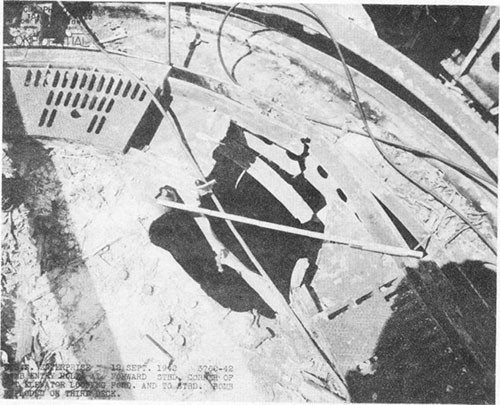
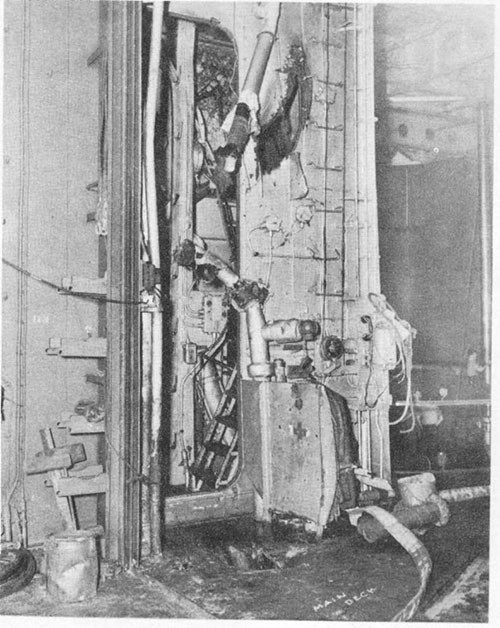
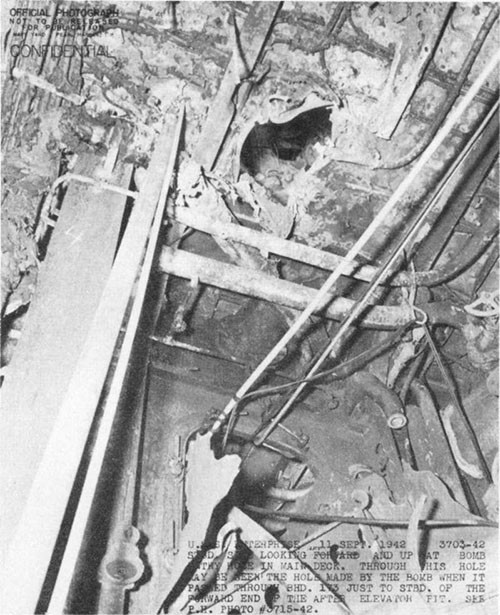
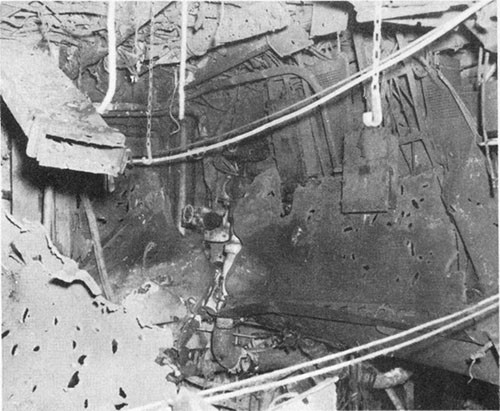
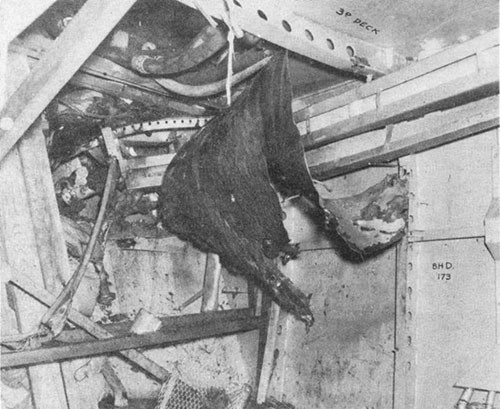
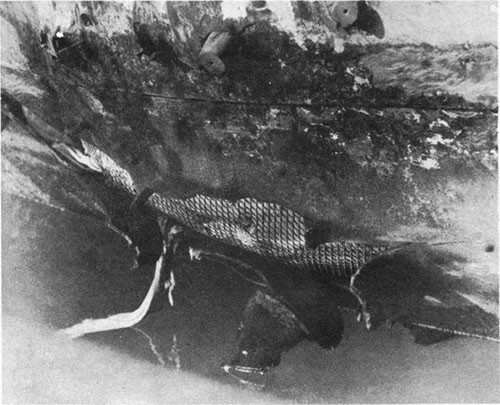
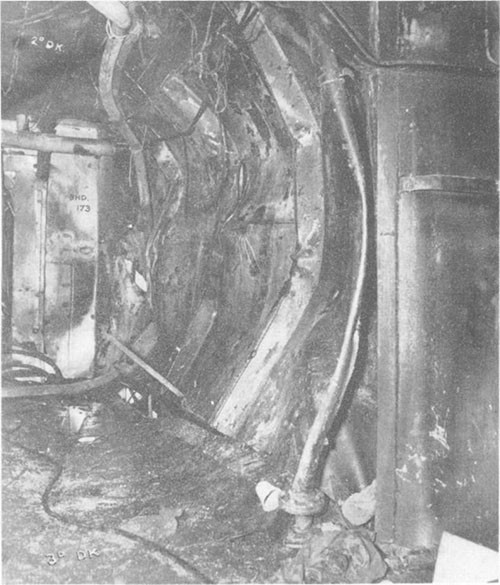
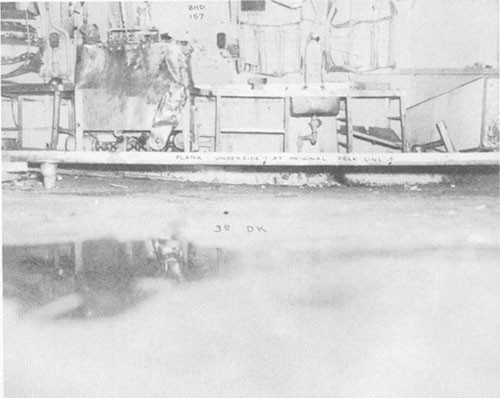
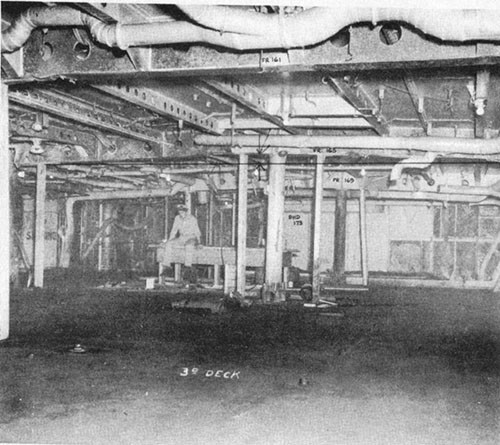
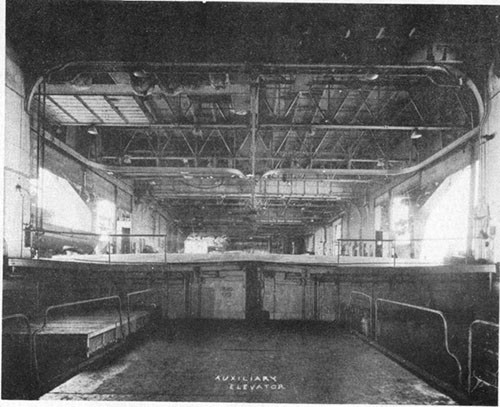
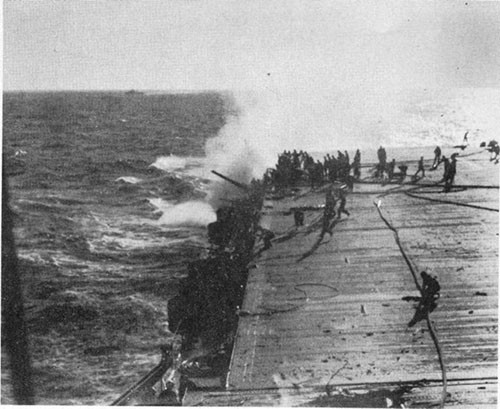
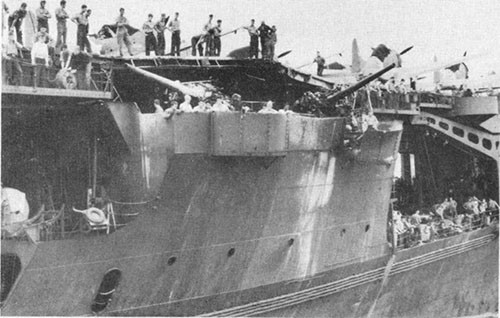


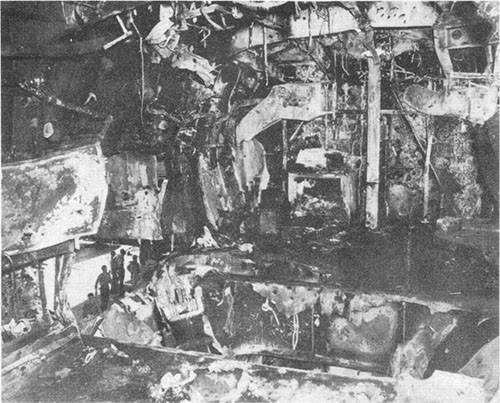
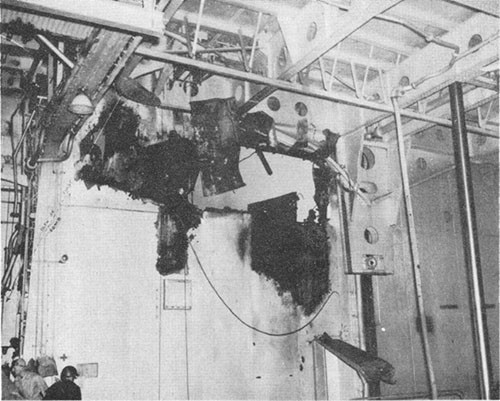
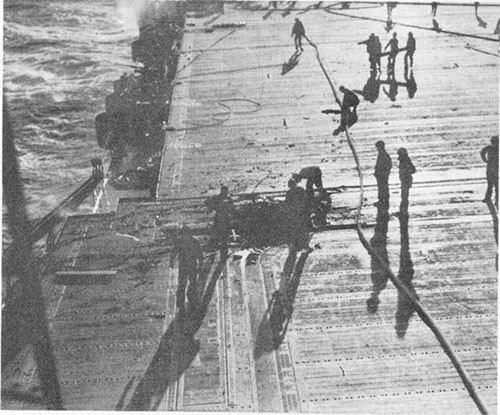
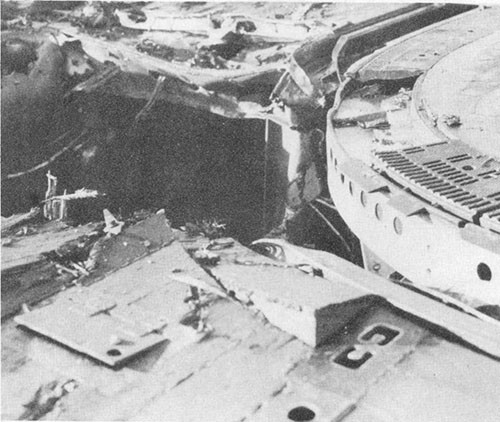
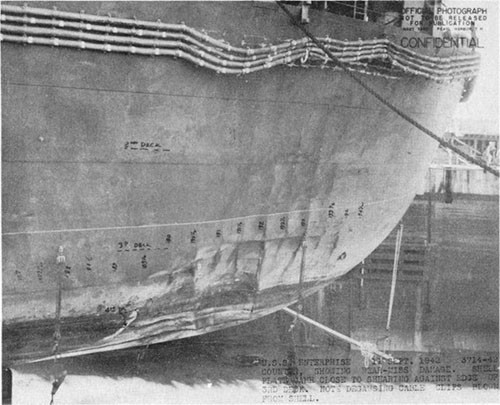
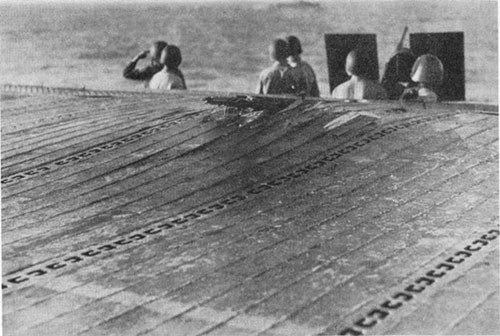
BOMB DAMAGE
BATTLE OF SANTA CRUZ, 26 OCTOBER 1942

1. 250 KG. BOMB HIT, FRAME 4
2. 250 KG. BOMB HIT, FRAME 44 1/2
3. NEAR-MISS 250 KG. BOMB, FRAME 129 1/2 STBD.
4. NEAR-MISS 250 KG. BOMB, FRAME 30 STBD.
F1-1. After leaving the Solomons on 25 August, ENTERPRISE proceeded via Tongatabu to Pearl Harbor, docking immediately upon her arrival on 10 September. She was undocked three days later and repairs were completed by 7 October. Besides battle damage repairs, some outstanding ShipAlts including installation of twelve additional 20mm guns, replacement of four 1.1-inch mounts with four 40mm quadruple mounts and installation of a search radar were accomplished.
F1-2. Damage to SARATOGA on 31 August and loss of WASP on 15 September, both from submarine torpedoes, had reduced the number of carriers available in the South Pacific to one - HORNET (CV8). After hastily replenishing her stores and training a new flight group, ENTERPRISE departed Pearl Harbor for the South Pacific with her escort plus the new battleship SOUTH DAKOTA on 16 October. On 24 October she joined HORNET's task force northwest of the New Hebrides Islands.
F1-3. In the meantime, despite the victory of the Battle of Cape Esperance on the night of 11-12 October, the support for U.S. troops on Guadalcanal was not proceeding well. The Japanese were preparing a large-scale land and sea offensive to drive the Americans out of the Solomons with a force which included four carriers, four battleships, nine cruisers and a large number of smaller ships. The U.S. task force ready to repel them was barely half as large, with only two carriers, one battleship, six cruisers and fourteen destroyers.
F1-4. Air reconnaissance made initial contact with elements of the Japanese force about noon, 25 October. The Battle of Santa Cruz took place the following day without contact being made at any time between surface ships of the opposing forces. During the course of the battle, planes from the Japanese carriers made at least eight separate attacks on the U.S. ships, damaging both carriers, the battleship, one light cruiser and two destroyers, at a cost of about 100 planes. HORNET and PORTER (DD356) were so extensively damaged that they were abandoned and sunk by our own force. ENTERPRISE was damaged by two bomb hits and two near-misses. Three waves of aircraft from HORNET and ENTERPRISE succeeded in damaging two of the Japanese carriers, a heavy cruiser and two destroyers, with the loss
of 74 planes, 20 of them in combat. Although the costly Battle of Santa Cruz appeared of dubious value to our cause, aircraft losses and damage inflicted on the enemy's carriers prevented him from providing effective air cover in the decisive Battle of Guadalcanal, 11-15 November 1942.
F1-5. Between 1115 and 1120 on 26 October, ENTERPRISE was attacked by 24 dive bombers which succeeded in making two direct hits and two damaging near-misses. The first bomb struck the flight deck at frame 4, port side, passed down and out through the ship's side and detonated in the air off the port bow. It produced heavy fragment damage and started two small fires. The second bomb struck at frame 44-1/2 on the port side of the flight deck and broke up below, part detonating on the hangar deck and part on the third deck in the forward repair party station. It caused blast damage in second and third deck living spaces, disablement of the forward elevator and two small fires. A near-miss bomb detonated about 8 feet below the waterline, 10 feet from the starboard side at frame 129-1/2, deflecting the shell plating below the armor, flooding three fuel tanks and causing shock damage to No. 2 H. P. turbine casing. Twenty minutes later, 25 torpedo bombers were driven off. At 1221, some 20 dive bombers attacked scoring a second near-miss with a bomb which detonated approximately 17 feet below the waterline and 8 feet outboard of the starboard shell opposite frame 30-1/2. The shell plating was distorted, several tanks were flooded and the pump and motor for No. 1 elevator were disabled by shock. At 1232, a fourth group of 15 dive bombers was repulsed without damage to ENTERPRISE.
F1-6. Despite the crippling damage to No. 1 elevator, ENTERPRISE continued in action and landed a large number of planes from the abandoned HORNET as well as her own. With the hangar deck full and planes parked on the flight deck as far aft as No. 1 elevator, aircraft continued to land successfully. The following day, ENTERPRISE proceeded south toward Noumea for repairs, arriving 30 October.
F2-1. The first bomb, released by a dive bomber at an angle of 45° and a height of about 1500 feet, pierced the flight deck at frame 4, 9 feet to port of the centerline (Photo F-1), passed through the transverse bent at frame 3, tumbled down through the forecastle deck just inboard of the port bitts about 2 feet forward of the forward perpendicular (Photo F-2) and exited 2 feet farther forward through the port shell above the main deck, tearing two of the externally-fitted degaussing cables (Photo F-3).
F2-2. This bomb detonated high order about 20 feet below the forecastle deck, close to the port bow. Blast effect on the ship was negligible, but the fragment attack was heavy. About 160 fragment holes were made, varying in diameter from 1/4 inch to 12 inches, the majority being small. Fragments perforated the ship's side in A-1-W, A-101-A and A-201-A, some continuing out through the starboard side (Photo F-4). Other fragments traveled upward through the port edge of the forecastle deck, the splinter shield of the 1.1-inch director and the flight deck. The maximum distance traveled by a
fragment was about 50 feet after which it pierced the 1/4-inch flight deck plating; the maximum thickness of plating penetrated was the 3/4-inch medium steel stem plate in way of the second deck at a distance of 10 feet.
F2-3. The second bomb, released from approximately 1500 feet in a 45° dive, pierced the flight deck at frame 44-1/2, 6 feet to port of the centerline, leaving a 14-inch diameter hole, struck the lower flange of the transverse bent at frame 43 and broke in two (Photo F-5). The conical tail section sheared away from the cylindrical body and hit the hangar deck 3 feet to starboard of the centerline at frame 39, tearing a 14-inch by 16-inch hole, and detonated (Photo F-6). The nose and body section pierced the hangar deck on the centerline at frame 40-1/2, making a hole about 14 inches by 37-1/2 inches and passed through hatch 2-39 in A-208-1L (Photo F-7) down to hatch 3-39 at the Repair II Station in compartment A-306-L where it detonated (Photo F-8).
F2-4. The detonation of the main portion of the bomb caused extensive blast damage on the third deck in A-306-L, A-307-1L, A-307-2L and A-308-1LM (Photo F-9) and on the second deck in A-208-1L, A-208-2M, A-208-3M and A-208-7L. Above the third deck, bulkhead 38 was deflected forward and bulkhead 43 aft. Watertight doors 3-43-2 and 3-54-2, open during the attack, were damaged and watertight door 3-43-1, which was closed, was blown off and wrecked. The third deck in A-306-L was wrinkled. The second deck was deflected upward unevenly a distance of 2 to 5 inches above A-306-L and A-307-1L, pulling up stanchions and tearing holes in the third deck. Bulkhead 38 above the second deck was distorted and both doors in it were wrecked. The hangar deck was deflected upward symmetrically between frames 37 and 54 to a maximum of 14 inches at frame 42 on the centerline (Photo F-10) except in way of the top of gasoline trunk A-513-T where it remained undeformed. Trunk A-513-T was not damaged. Hatch 3-39 to magazine trunk A-409-T was demolished and watertight hatch 3-42 was distorted. The staterooms and Repair II locker in A-306-L were demolished. Officers' washroom A-307-2L and all staterooms in A-307-1L were wrecked. Blast effect in A-308-1LM was confined to the port side, partially wrecking the warrant officers' messroom and slightly damaging the staterooms. Blast damage on the second deck between frames 38 and 54 may have resulted from both detonations. All staterooms in A-208-1L and baths A-208-4L and A-208-5L were demolished. The lightly constructed bulkheads of ammunition handling rooms A-208-2M and A-208-3M and their doors 2-41-3 and 2-41-2 were demolished. Officers' washroom A-208-7L was partially wrecked. On the main deck, the sliding door to the bomb elevator at frame 72 was blown off and hatch 1-39 was wrecked.
F2-5. Fragments traveled downward from the point of detonation of the nose and body of the bomb through the deck of A-306-L and hatch 3-39. Hatch 4-39 was pierced at the edge by a fragment, destroying the watertight integrity. Fragments flew sideward in all directions, but none penetrated upward through the second deck. Fragments from the tail section penetrated downward through the second deck, sideward through the starboard bulkhead of No. 1 elevator trunk slightly gouging and burring the elevator plungers, and through doors 1-39-1 and 2. Other fragments traveled upward and through the flight deck and No. 1 elevator. The greatest thickness pierced by fragments from the main portion of the bomb was 1/2-inch STS, 9 feet distant. Fragments from the tail passed through 1/4-inch medium steel plate at a distance of 40 feet.
F2-6. The first damaging near-miss occurred when a bomb detonated about 8 feet below the waterline, 10 feet outboard of the starboard shell opposite frame 129-1/2. Shock to the ship was moderate and a general flexural vibration of low frequency occurred of an amplitude estimated by the Commanding Officer as 1-1/2 feet.
F2-7. The shell was opened by rivet failure along the seam between "G" and "H" strakes between frames 124 and 129 and also at the upper seam of "H" strake between frames 131 and 134 (Photo F-11). Tanks D-3-F, D-13-F and C-35-F were opened to the sea. Plating was deflected inward generally over an area about 48 feet by 17 feet between frames 123 and 135, from the upper edge of the armor belt at the fourth deck almost to the bilge keel. Maximum deformation was about 18 inches at the lower edge of "H" strake. Evidently the lap seam between "G" and "H" strakes provided local discontinuity of structure, as the plating was bent very sharply inward just above the seam (Photo F-11). All structural members behind the deflected plating were buckled between frames 124 and 135 (Photos F-12 and F-15). The armor was sprung in a maximum of 10 inches and held by the bent plating behind. No. 2 torpedo bulkhead immediately inboard and the fourth deck were not damaged. Bulkhead 123 was not distorted, but bulkhead 130 was badly buckled (Photos F-13 and F-14) and torn at the face plate of the longitudinal stringer behind the lower edge of the armor belt. Bulkhead 134 also was slightly buckled but not torn (Photo F-16). There was no penetration of structure by fragments.
F2-8. During the third attack of the day, ENTERPRISE was heeled to port in a hard right turn when the second damaging near-miss, a bomb released from a Japanese plane in a 45° dive, glanced off the starboard side at the waterline, frame 30. It detonated about 17 feet below the waterline and 8 feet outboard of the starboard shell opposite frame 30-1/2. Shock was moderate, causing a general flexural vibration of low frequency with an estimated amplitude of one foot.
F2-9. The shell plating was deflected inward over a roughly elliptical area about 48 feet by 25 feet, between frames 23 and 35, from the first platform level to the keel. The maximum indentation was about 2-1/2 feet, at frame 30-1/2, above and below the lower longitudinal behind "F" strake (Photos F-17 and F-18). Four small cracks (circled in Photo F-18) were torn in the shell by the buckling of frames and longitudinals which pulled away from the plating. One crack occurred at the juncture of bulkhead 29 and watertight longitudinal 2-1/2, opening up adjoining compartments, A-6-W, A-7-V, A-11-V and A-901-V. The largest crack was 9 inches by 1 inch at the juncture of tanks A-901-V and A-11-V. All frames, floors and bulkheads in way of deflected plating were bent or buckled (Photos F-19 and F-23) and frames 30, 31 and 34 were broken. The 4-inch STS bulkhead at frame 35 held rigid and no distortion occurred aft of it. Bulkhead 29 was carried away above longitudinal 2-1/2 interconnecting tanks A-7-V and A-11-V and a weld cracked below longitudinal 2-1/2 interconnecting tanks A-6-W and A-901-W. Bulkhead 26 between A-5-W and A-6-W was buckled and forced away from the shell, making a 3-inch by 1/32-inch opening. Bulkhead 18 was bulged forward opening two small leaks near the keel between A-3-A and A-4-W. Inner bottom plating, extending to the fourth deck was bulged inboard in spaces A-9-E and A-6-W from frame 34 to bulkhead 26 (Photo F-24) with a maximum deflection of 15 inches at a point just below longitudinal 2-1/2 at frame 31.
F2-10. The weakened structure showed signs of panting with the ship underway; so temporary shoring was installed in A-505-A to strengthen the first platform over A-9-E and A-6-W and the inboard bulkheads of A-7-V and A-11-V. There was no penetration of structure by fragments.
F2-11. Several other bombs detonated close enough to the ship to throw geysers of water on the side. The only damage noted, however, was a pattern of small fragment holes in the hangar curtain at frame 102 on the port side, probably resulting from a near-miss off frame 95.
F3-1. The "M" and "F" loops of the degaussing cables externally fitted on the port bow were cut by the first hit as it passed out through the shell and by fragments. About 20 lighting cables located on the forecastle forward of frame 9 were also cut by fragments. No. 2 radio direction finder loop on the port catwalk forward was knocked over the side and the receiver and power pack were wrenched loose from the bulkhead of the direction finder room.
F3-2. As a result of the second hit, firemain risers were carried away at frame 40, port and starboard, in A-208-1L and on the port side in A-306-L. The main had been segregated at frame 111 port and starboard prior to the action, creating 4 separate sections. Ventilation blower 2-43 was damaged, its control panel destroyed and motor shaft bent and all ventilation ducts in the blasted areas were demolished.
F3-3. There were about 30 gouges and burrs on the main elevator plungers, the largest being about 1 inch long, 1/2 inch wide and 1/16 inch deep in the starboard plunger. The starboard pitch and roll guide and gear rack were also slightly gouged.
F3-4. Remote control and telephone cables for GROUP I 5-inch battery, all power, lighting, fire control and I.C. cables in A-208-1L and A-306-L and many cables in A-307-1L and 308-L were cut. Controllers for two sprinkling valves were damaged, several power panels destroyed and two ammunition hoist motors were torn loose from their foundations in A-208-1L. The flooding and sprinkling remote control station in A-306-L and auxiliary Battle Dressing Station II were destroyed. Vacuum tubes were shattered and leads broken by shock in all transmitters in Radio II (A-0201-C).
F3-5. The most serious damage from the shock of the first near-miss bomb detonation was a crack which occurred in the after bearing pedestal of No. 2 H.P. turbine. The pedestal was cast iron and formed an integral part of the after lower section of the turbine casing. The crack extended fore and aft on the inboard side, just above the fillet to the lower flange of the pedestal.
F3-6. The cracked pedestal was repaired temporarily by securing an angle support, built up of a 1-inch plate vertical leg, 1-1/4-inch plate
horizontal leg and 1-1/4-inch plate gussets to the foot and vertical webb of the pedestal which were ground to make a neat fit. The horizontal leg of the angle support was secured by extra long bolts passing through the foot of the pedestal, and the vertical leg of the angle was secured to the webb of the pedestal by eight body-bound bolts and one cap screw.
F3-7. In addition to the cracked pedestal and also as a result of the shock of the first near-miss, the forward and after gyros spilled a small quantity of mercury, the foremast was rotated in its socket throwing the SG radar wave guide out of alignment, the YE homing antenna drive shaft was disabled, an overboard flushing line was cracked at frame 130 in C-409-L and fourteen fuel oil tank level gauges were broken.
F3-8. Shock of the second near-miss threw No. 1 elevator pump and motor off their foundation in A-9-E and bent the drive shaft. This, together with damage from the second hit, effectively disabled the elevator. In addition, some lengths of high pressure hydraulic piping were distorted and ruptured, the secondary drain pump in A-9-E was thrown off its foundation and broken and overboard piping and valves from the pump were ruptured. Two fresh water pumps were damaged.
F4-1. Peak tank A-1-W was flooded by seas coming in through fragment holes from the first bomb hit in way of and above the waterline. No attempt was made to control this flooding until ENTERPRISE returned to port. The tank was then pumped out with submersible pumps and the holes were patched.
F4-2. Flooding after the second hit came from the broken firemains in A-208-1L and A-306-L. Firemain valves 5-56-2 and 5-57-5 were closed to stop flooding from ruptured risers at frame 40 after it was found that remote controls for root valves in the risers were inoperable and the valves were inaccessible because of 6 feet of flood water in A-406-A. A-410-A and A-412-A were flooded to a depth of two feet from A-307-1L through holes in the third deck opened by the pulling up of stanchions. A small amount of water ran down ventilation duct outlets, located just above the second deck, into magazines A-509-M, A-510-M, A-514-M, A-520-M, A-521-M, A-524-M, A-601-M, A-602-M, A-704-M and A-705-M. Some water also leaked through the fragment hole in hatch 4-39 into magazine trunk A-508-T.
F4-3. The four rows of wing tanks in way of the first near-miss were generally empty except for tanks in the second row between torpedo bulkheads 2 and 3, which were about three-quarters full of fuel oil. Three outboard tanks, C-35-F, D-3-F, and D-13-F, were holed by the detonation and flooded to the waterline. C-35-F and D-3-F flooded immediately. D-13-F flooded more slowly, at about 3000 gallons per hour, and was controlled with pumps. A list of 2-1/2° to starboard resulted from the flooding.
F4-4. Tank relief valves in compartments C-409-L and D-401-L above the flooded tanks were gagged to prevent progressive flooding. The list was removed by partially counterflooding six diagonally opposite forward tanks, A-48-F, A-54-F, B-14-F, B-16-F, B-22-F and B-28-F. Although no explanation was given for not completely flooding two or three of these tanks, it is possible they were already partially full.
F4-5. Compartment A-7-V flooded completely and compartments A-11-V and A-901-V flooded to a depth of 19 feet in about 1-1/2 hours through small cracks in the hull opened by the second near-miss. A-9-E flooded to the fourth deck through ruptured drainage piping and through the overflow pipes from fresh water tanks, A-4-W, A-5-W and A-6-W. Very slow flooding occurred in these three tanks through cracked plating and bulkheads. A-3-A also flooded to a depth of almost six feet.
F4-6. The slow flooding resulting from the second near-miss could not be controlled by the ship's pumps because the drainage pump in A-9-E was disabled and subsequently submerged and severed power leads in the vicinity of frame 35, cut by the second bomb hit, prevented the use of electric submersible pumps until casualty power leads could be rigged.
F4-7. Drafts resulting from the flooding and counterflooding were approximately 30 feet forward and 29 feet aft. Drafts prior to the action were approximately 26 feet forward and 28 feet aft.
F5-1. Heat generated as the first bomb pierced the flight deck set fire to planking in way of the hole. A plane parked nearby caught fire and leaked gasoline which burned on the deck. Passage of the bomb also set fire to some rags, bunting and small cordage in A-101-A. The burning plane was pushed over the bow and the small fires quickly extinguished.
F5-2. Several fires resulted from the twofold detonation of the second bomb. Three planes triced up in the overhead and one plane on the hangar deck near frame 40 were ignited by hot fragments or flash from the detonation of the tail section. These fires were quickly extinguished by the sprinkling system which was turned on immediately in the forward end of the hangar. Fires in bedding, office files, etc. in A-105-L, started by hot fragments, also were extinguished without difficulty.
F5-3. A small fire started in protective clothing and personal effects in A-306-L from detonation of the main portion of the second bomb. This fire was extinguished by water from the ruptured firemain riser at frame 40 on the port side of the compartment. The only serious fire, a combination electrical and Class A fire, occurred in A-208-L. Dense smoke filled the compartment and hampered firefighters, but was partially cleared by turning on the supply ventilation in A-309-LM and A-310-11 M. The fire was brought under control within an hour by water and CO2.
F6-1. Recognizable fragments of the second bomb were recovered, including several pieces of the tail fuze, small pieces of the nose fuze, pieces of the nose, body and conical tail and one tail strut. With these, the bomb was identified as a 250 Kg No. 25 "Land" bomb which corresponds approximately with the U.S. 500-pound GP type. The conical tail section was secured by a row of screws to a collar, which in turn was riveted to the cylindrical body. This weak connection, later corrected by the Japanese, probably caused the rupture of the bomb. The tail cone, containing about one quarter of the explosive, fell to the hangar deck and detonated, set off by the tail fuze as described in paragraph F2-3. From the large size of the fragments, the fact that unburned powder still clung to these fragments and the extent of damage, it is estimated that the tail portion detonated low order. It is believed that the main portion also detonated low order.
F6-2. Although no conclusive evidence exists for identifying the other three bombs, it is believed that they were of the same type and size. The first bomb detonated high order, judging by the excellence of the fragment attack, which was, however, of a different character than that of the first bomb hit on 24 August. The size of the holes left in the ship's structure by the passage of the bomb indicates a diameter of about 14 inches. The two near-miss bombs which struck close to the starboard side also evidently detonated high order. As experience has often indicated, the water prevented underwater fragment attack. The shock of the detonation was in both cases sufficient, however, to open up the shell by structural failures.
F7-1. Again, as during the Battle of the Eastern Solomons, the excellent damage control organization of ENTERPRISE prevented fires from getting out of hand and enabled the ship to continue in the battle as an almost normal fighting unit. Measures taken to train the crew and to strip the ship of all inflammable material had been continued at an accelerated pace. Linoleum and paint were being removed, wooden articles, overstuffed furniture and transoms had been put ashore, office files, libraries and publications had been reduced to a minimum, and a policy of keeping only one week's supply of inflammable materials stowed above the waterline had been established.
F7-2. As in the action of 24 August, flooding of watertight compartments through piping, ventilation ducts, etc., occurred. Firefighting water found its way down ventilation ducts into some of the magazines, and elevator pump room A-9-E flooded partly through relief valves in overflow pipes from the three fresh water tanks forward. In way of the near-miss aft, however, tank relief valves were accessible and were gagged by the ship's force to prevent progressive flooding in spaces above those opened to direct flooding.
F7-3. Flooding resulting from the two near-misses probably could have been avoided had the outboard spaces been full of water instead of empty.
F7-4. The crack sustained by the after bearing pedestal of No. 2 H.P. turbine casing from the shock of the first near-miss again demonstrated the poor shock resisting qualities of cast iron. During the ship's availability in the summer of 1943, this pedestal casting was replaced with one made of cast steel. It was decided, however, not to replace the undamaged cast iron pedestals of the other turbines. It is, therefore, of particular interest to note that the casualty occurred again on 11 April 1945 on No. 3 H.P. turbine as a result of an underwater detonation.
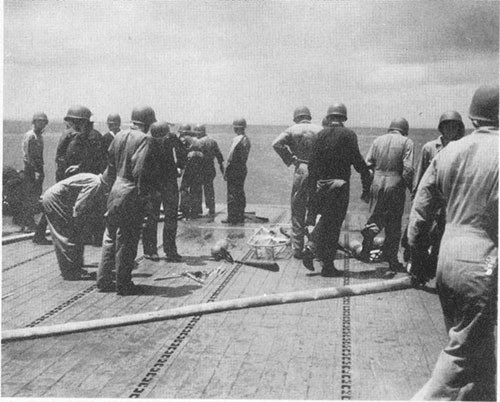
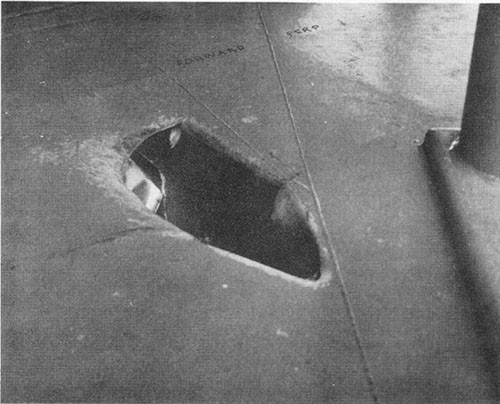
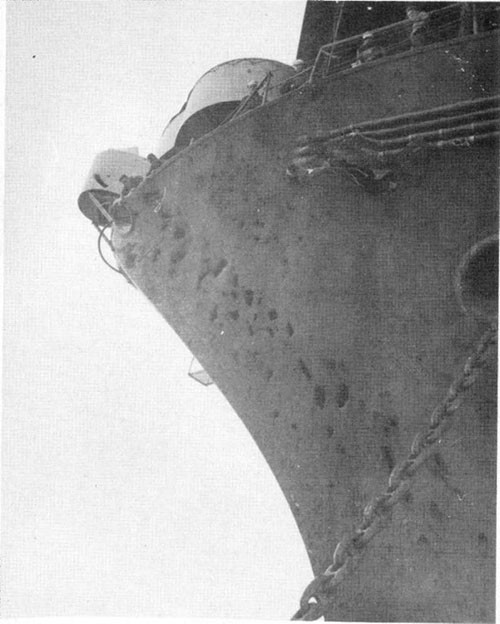
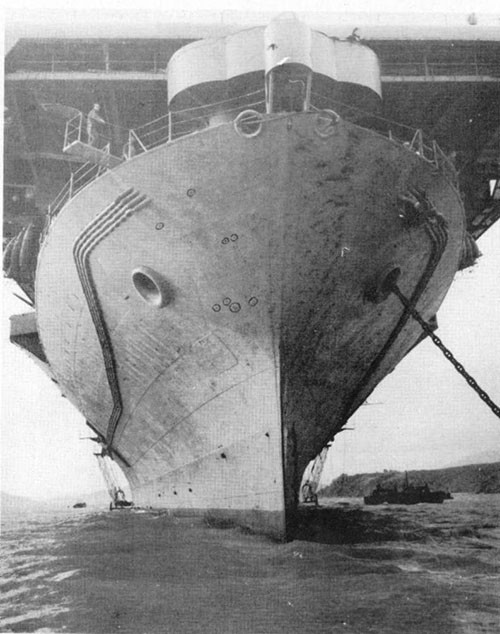
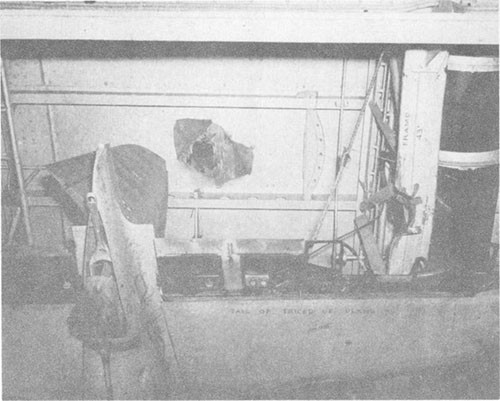
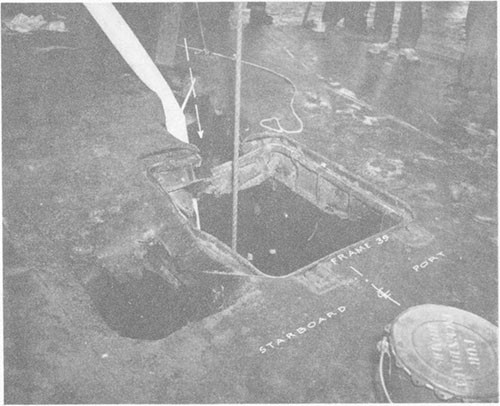
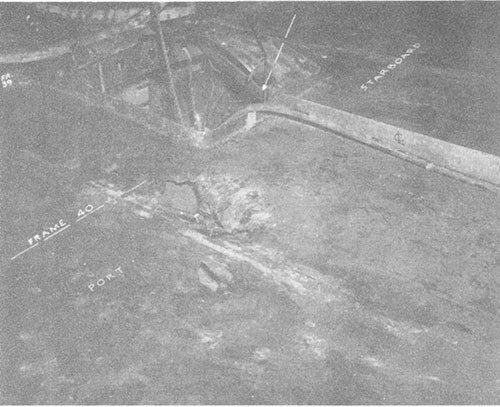
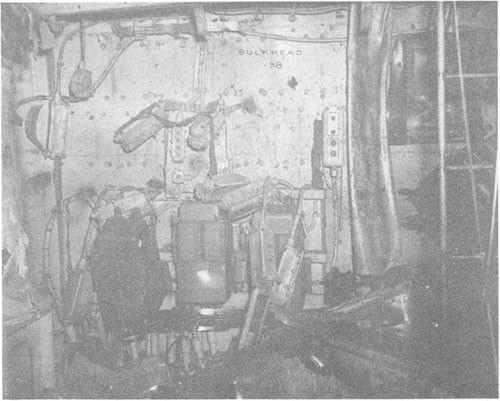
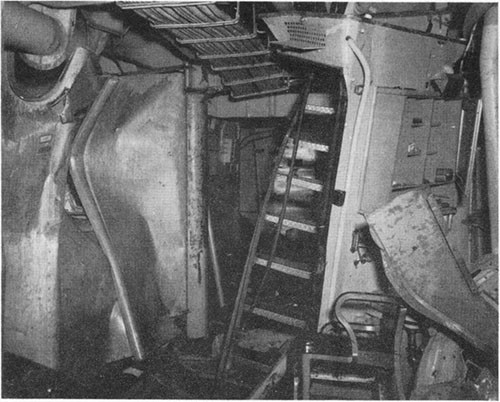
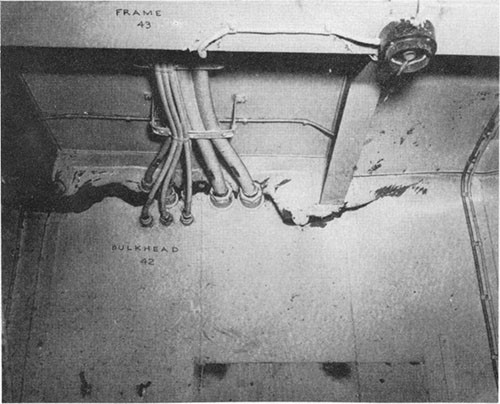
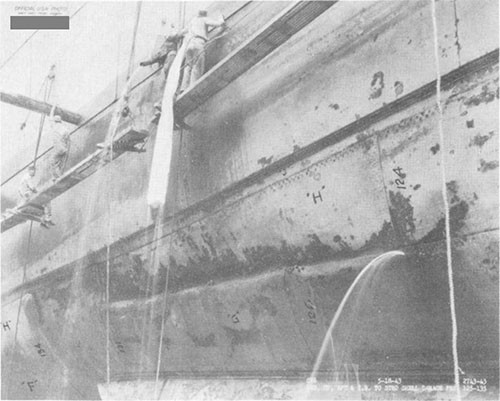
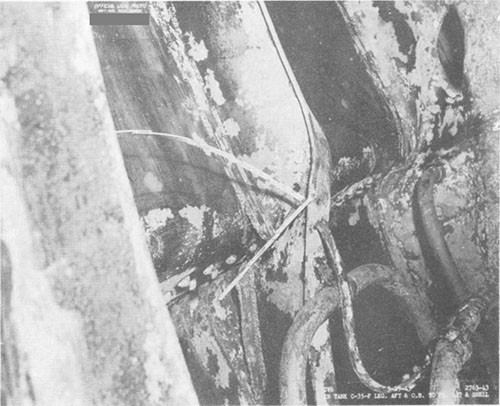
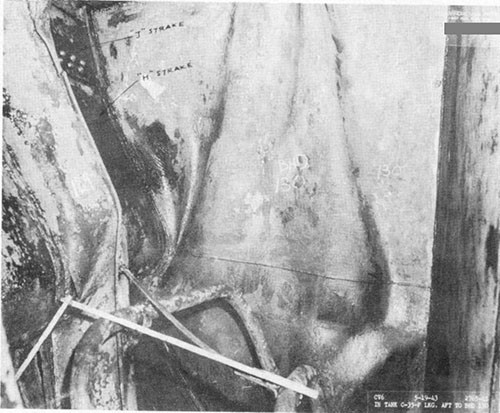
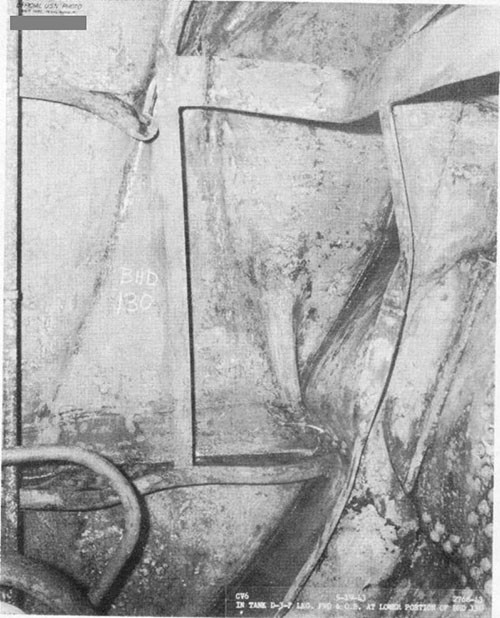
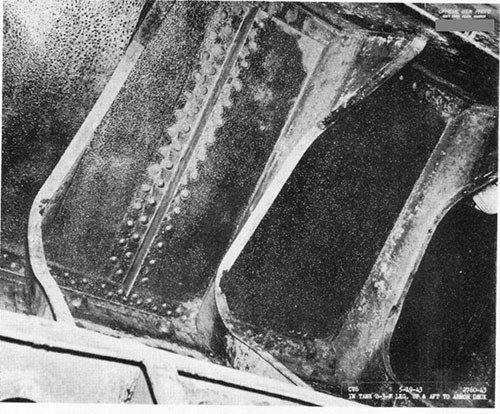
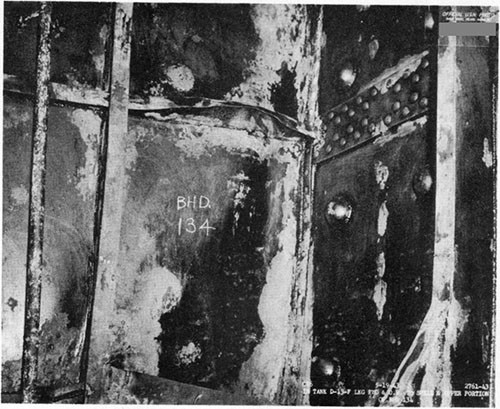
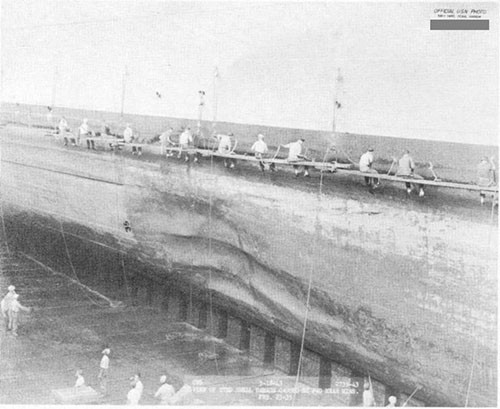
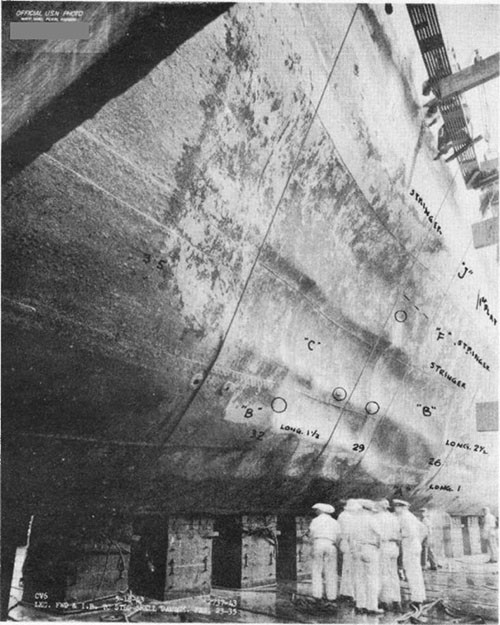
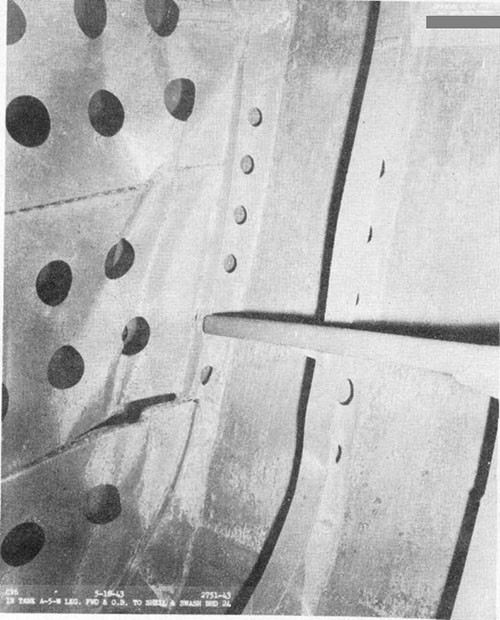
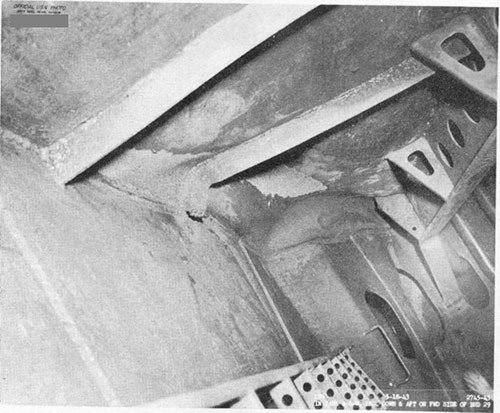
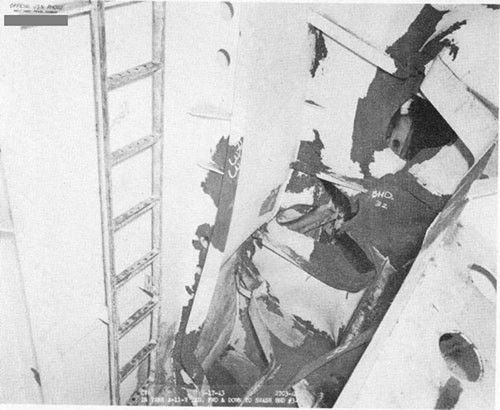
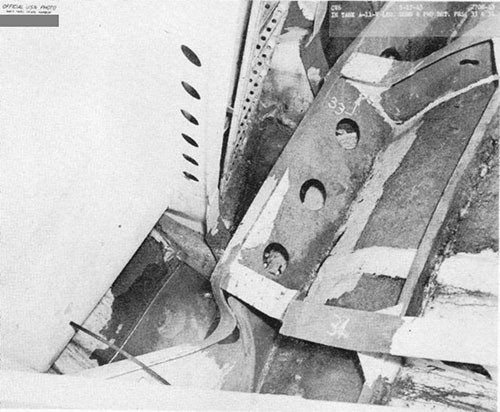
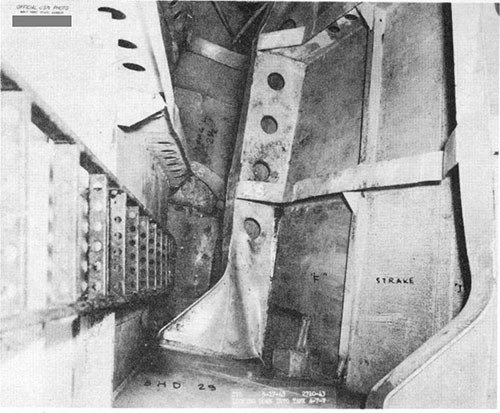
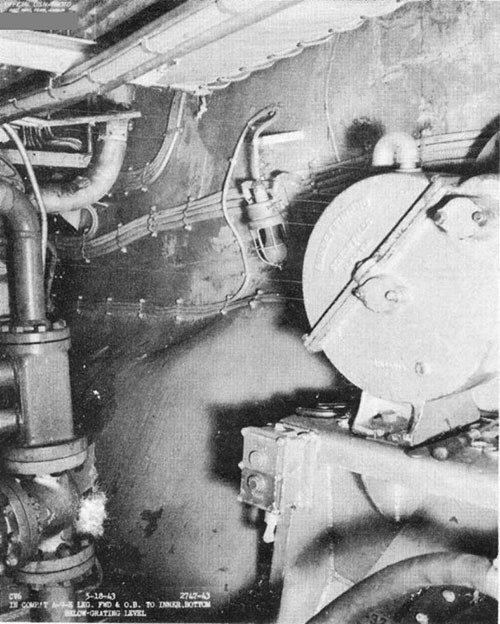
SECTION G
HISTORY
30 OCTOBER 1942 TO 18 MARCH 1945
G1-1. In Noumea, shipfitters and machinists from VESTAL (AR4), a construction battalion and the ship's force worked continuously to repair damage incurred in the Battle of Santa Cruz. Work was not completed on 11 November, however, when ENTERPRISE was ordered to proceed to Guadalcanal.
G1-2. The Japanese had assembled a large force with which to make a last supreme effort to drive the U.S. forces from Guadalcanal. It was essential to reinforce our troops and destroy the Japanese force. ENTERPRISE's planes, operating from Henderson Field, gave air support to U.S. ground forces on Guadalcanal and made strikes against the Japanese Fleet in the battle which culminated in the defeat of a superior Japanese force by two U.S. battleships and escorting destroyers in the night surface engagement of 14-15 November, and the full retreat of the remnants of the Japanese Fleet on 15 November.
G1-3. Unremitting repair work on ENTERPRISE succeeded in readying the forward elevator for testing at the height of the battle. However, because of the possibility that it might not come up again after being lowered, the tests were postponed and ENTERPRISE completed her part in the engagement with only two elevators operating. After her return to Noumea on 16 November, work was continued, although no effort was made to repair the damage caused by the two near-misses received on 26 October beyond restoring watertight integrity and stiffening weakened frames forward as extended drydocking would have been required. Canvas partitions sufficed to replace demolished joiner bulkheads in the officers' country forward until permanent repairs could be made the following summer.
G2-1. From December 1942 until May 1943, ENTERPRISE operated out of Espiritu Santo spending a relatively quiet time in port with occasional sorties for patrol, submarine hunting or training duties. The only action occurred at the end of January when her planes provided air cover for CHICAGO which had been damaged by Japanese bombers and torpedo planes in the evening of 29 January. Unfortunately, a force of 11 or 12 Japanese torpedo planes, intercepted in a projected attack on ENTERPRISE, succeeded in hitting CHICAGO with four additional torpedoes which sank her. The enemy planes were all shot down subsequently by AA fire and fighter planes.*
___________
* BuShips War Damage Report No. 37.
G2-2. ENTERPRISE sailed for Pearl Harbor on 1 May where she was drydocked from 18 to 29 May for the repair of the underwater damage suffered in the Battle of Santa Cruz. On 27 May, Admiral Nimitz presented the award of the Presidential Unit Citation to ENTERPRISE, the first carrier to receive this distinction.
G3-1. After leaving drydock on 29 May, ENTERPRISE remained in Pearl Harbor during June and part of July. A few alterations, including fitting of identification radar, removal of paint and inflammable stores to fume-tight compartments below the waterline fitted with mechanical ventilation and CO2 fire extinguishing systems, and fitting of watertight quick-acting scuttles in hatches leading to elevator machinery and pump room A-9-E, were accomplished during this period.
G3-2. On 14 July, ENTERPRISE departed Pearl Harbor for Puget Sound where she was placed in No. 5 graving dock on 23 July. During the period from 23 July to 26 September blisters were fitted between frames 36 and 150 to effect improvement in stability necessitated by the increase in topside weights resulting from wartime alterations. Her original gasoline tanks were replaced with saddle tanks which had been devised to give increased protection against underwater attack, shells, bombs, splinters, etc. (A discussion of this type of tank is included in BuShips War Damage Report No. 39 "WASP").
G3-3. In addition to the two major structural alterations mentioned above, compartments A-18 and A-25, made available by the change in gasoline stowage, were altered to provide additional 40mm, plane ammunition and incendiary bomb stowage; gasoline mains were extended aft; a manually-controlled inert gas system was installed to replace the CO2 system for protection and purging of gasoline lines; and air-driven defueling pumps were fitted at each fueling station on the flight and hangar decks to expedite the draining of fuel tanks in returned planes.
G3-4. Firefighting facilities were improved by the installation of manually-controlled fixed fog nozzle systems in many spaces and steam smothering lines in the machinery spaces and by replacing chemical foam generators with new design mechanical foam pressure proportioners. Additional cutout valves were fitted in the damage control and firemain systems and two 1000 GPM Diesel-driven centrifugal pumps were installed, one in A-9-E and one in D-523-E, and connected to the fire-mains.
G3-5. The entire ventilation system was revised to improve watertight integrity and living conditions. The system was altered in the steering motor room to prevent a recurrence of the casualty of 29 August 1942 and terminals of all natural exhaust ducts from forward magazines were raised 5 feet above the second deck.
G3-6. Other alterations included fitting 60-pound STS plating around trunk D-304-T between the second and third decks leading to the after
magazines; installation of internal degaussing cables; addition of several radars; replacement of the two forward flight deck catapults with units of a later design; and an increase of armament by the addition of 8 - 40mm twin mounts and several 20mm guns. All alterations, trials, etc. were complete and ENTERPRISE was ready for sea 31 October.
G4-1. On 1 November, ENTERPRISE departed Puget Sound for Pearl Harbor where on 10 November she joined the task force which was to support the landings on Tarawa, Makin and Apamama in the Gilbert Islands. On board were newly organized teams of night fighters, "Bat Teams," each consisting of a radar-equipped Avenger torpedo plane and two Hellcat fighters. ENTERPRISE planes struck at Makin during the three-day period 19-21 November and during the nights of 24, 25 and 26 November her night fighters successfully repulsed attacks by Japanese torpedo bombers against the task force. ENTERPRISE withdrew on the afternoon of 28 November, her part in the operation against the three islands completed. On the way back to Pearl Harbor she circled north of the Marshalls in order to launch a strike against shipping and shore installations on Kwajalein. She arrived in Pearl Harbor 9 December.
G4-2. ENTERPRISE departed Pearl Harbor 16 December to participate in the landings on Kwajalein in the Marshalls. Operating to the south and west of the islands, she provided planes for the bombardment of enemy aircraft and ground installations, for combat air patrol, anti-submarine patrol, photographic reconnaissance and for direct support of landing troops. The Japanese offered comparatively little resistance. No special night fighters were required and the occupation was completed by 4 February.
G4-3. On 16 February, planes from ENTERPRISE participated in strikes against shipping and oil storage installations at Truk. Although the major units of the Japanese Fleet had already left that base, six enemy combatant ships and many enemy auxiliaries were sunk or damaged. The strikes continued through the seventeenth. Then the U.S. carriers and their escorts retired rapidly to the northeast, pausing to launch two strikes against shore installations on Jaluit, 20 February.
G5-1. On 7 March, ENTERPRISE headed once more for the Southwest Pacific where her planes provided air support, combat air patrol and anti-submarine patrol for the landings on Emirau. She then joined Task Force 58 and participated in strikes against Peleliu and Koror in the Palau Islands, Yap and Ulithi in the western Carolines and, as the group retired eastward, against Woleai.
G5-2. ENTERPRISE planes flew their first strikes against airfields and installations in Hollandia on 21 April in support of amphibious operations in Tanahmerah Bay. She remained in the area
until 26 April, when, after a final strike against Wakde Island, she retired to the newly won harbor at Manus to repair a hydraulic leak in the steering engine and to pick up replacements.
G5-3. On 29 and 30 April, six strikes were flown by ENTERPRISE planes each day against ground installations and aircraft on Truk. Her task group then continued eastward to Majuro, where they anchored 4 May.
G5-4. After a month of relative inactivity, ENTERPRISE departed Majuro on 6 June with Task Group 58.3 to support landings on Saipan. Her first fighter sweeps were sent against the Island on 11 June and continued for the next three days. On 15 June the landings took place, supported by carrier planes and bombardment by surface ships. While repulsing an air attack, superficial damage to superstructure was sustained when a 40mm shell from a U.S. vessel struck ENTERPRISE.
G5-5. It was suspected that the Japanese Fleet was in the vicinity, and during 17 and 18 June the U.S. ships worked around to the west of Saipan, searching for the enemy fleet. On 19 June the U.S. task group was attacked by more than 400 Japanese dive bombers and torpedo planes, the majority of them carrier type aircraft. So effective were the combat air patrol and anti-aircraft defense, that approximately 366 enemy planes were destroyed, ENTERPRISE fliers accounting for 19. Unfortunately search planes could not discover the Japanese naval force until the afternoon of the twentieth, some 670 miles west of Saipan. Moderate damage was inflicted on the enemy and one carrier was sunk. The Japanese retired rapidly westward so that, although contact was maintained by search planes through the following day, the distance was too great to launch a strike. ENTERPRISE and the other U.S. vessels then returned closer to Saipan from where she launched daily strikes against Guam between 28 June and 5 July. She returned to Eniwetok on 9 July and from Eniwetok proceeded to Pearl Harbor where she had availability at the Navy Yard from 16 July to 3 August.
G6-1. At the cost of hard fighting and many casualties, Saipan was established as a base from which the strategic bombing of Japan could take place. In addition, it afforded protection to the northern flank of the line of advance from the Central Pacific to the Philippines, toward which the amphibious forces of the Southwest Pacific were also headed. A base in the western Carolines was needed, however, and the Palau Islands were chosen.
G6-2. To divert attention from the projected landings on Peleliu in the Palau Islands, Task Group 38.4, which included ENTERPRISE, made a raid on the Volcano and Bonin Islands. While the other carriers of the task group struck at Iwo Jima, she launched fighter sweeps against Chichi Jima and provided combat air patrol and photographic reconnaissance.
G6-3. After a brief stop at Saipan, ENTERPRISE sent fighter sweeps and photographic missions against Yap and Ulithi on 6, 7 and 8 September, followed by strikes against Malakai Harbor in the Palau Islands on 10 and 11 September.
G6-4. On 15 September, troops landed on Peleliu with planes from ENTERPRISE furnishing a part of the direct air support. She continued to provide air support until 18 September when she retired to Manus.
G6-5. The task group returned to patrol duties west of the Palaus on 27 September remaining for the next eight days ready to intercept any attempt by the Japanese Fleet to repeat the tactics used at Saipan.
G6-6. During the operations against the Palau Islands, another task group was making the first large raids on Formosa and the northern Philippines. These were designed to divert the Japanese away from the amphibious operation and to whittle down the enemy's strength in the Philippines. Opposition was so light that the decision was made to accelerate the speed of advance by landing directly in the Philippines.
G6-7. ENTERPRISE's part preliminary to this landing was to strike north of the Philippines as a unit of one of three task groups. On 10 October her planes flew against Okinawa Shima in the Ryukyus. The next day she provided combat air patrol while planes from other carriers attacked northern Luzon. On 12 and 13 October, strikes were made against strong Japanese installations on Formosa, On 15 October, from a position east of Luzon, ENTERPRISE sent a fighter strike and sweep against Manila and on 18 and 19 October her planes made bombing and strafing strikes against aircraft and installations at Legaspi and Manila.
G6-8. The landings on Leyte took place 20 October, with ENTERPRISE planes among the air support groups. She left the next day, however, and headed toward Ulithi as the task group had been out since 24 September and other ships were available to cover the operations. But on the twenty-third, intelligence advised that the Japanese Fleet was at last coming out of hiding to throw all of its weight against the U.S. foothold in Leyte Gulf and all available American vessels were readied for action.
G6-9. The Japanese attack was three-pronged. One force came up from the south, through the Sulu Sea toward Surigao Strait, south of Leyte; a central force passed north of Palawan into the Sibuyan Sea, heading for San Bernardino Strait, north of Samar; and a northern force sailed south from Japan directly toward Samar and Leyte. The resulting Battle for Leyte Gulf accordingly developed in three parts, known respectively as the Battle of Surigao Strait, the Battle off Samar and the Battle off Cape Engano.
G6-10. ENTERPRISE planes participated in action against all three of these Japanese Forces. On the morning of 24 October, they damaged two battleships and a cruiser in the Sulu Sea and in the afternoon they scored torpedo and bomb hits on a third battleship in the Sibuyan Sea. During the night and next day, the Seventh Fleet bore the brunt of the attacks from the Japanese southern and central forces. The southern force was routed in the night Battle of Surigao Strait and the next morning the powerful central force was engaged by a task unit of CVE's. During
this time, ENTERPRISE had steamed north with the Third Fleet to engage the Japanese northern force off Cape Engano. Five strikes launched by ENTERPRISE on 25 October assisted in sinking four Japanese carriers and damaging battleships and other units.
G6-11. This ended ENTERPRISE's part in the largest Naval engagement of the war. For the remainder of the month, she remained on patrol east of Samar and Leyte, providing combat air patrol, survivor searches and search-attack groups. On 30 October, a strong enemy air attack developed which included suicide plane crashes on FRANKLIN* (CV13) and BELLEAU WOOD (CVL24). One ZEKE, although on fire from repeated hits, dived on ENTERPRISE from the starboard beam, crossed the after flight deck, narrowly missed parked planes and fell into the sea on the port quarter. The next day the task group departed for Ulithi.
G6-12. ENTERPRISE spent only three days at Ulithi, leaving on 5 November with Task Group 38.4. On 11 November, a successful strike was made on a Japanese convoy landing troops in Ormoc Bay on the west side of Leyte and on 13-14 November a heavy attack was made against shipping in Subic and Manila Bays. Many ships were sunk or damaged. After routine patrols and fueling near Palau, the task group returned on 19 November to attack Clark Field and Subic Bay.
G6-13. After the strike of 19 November, ENTERPRISE retired eastward sending planes against the airfields at Yap before anchoring in Ulithi on 22 November. Five days later, she departed for Pearl Harbor arriving 6 December for two weeks' availability at the Navy Yard where new four-bladed propellers were fitted in an effort to reduce vibration during high speed turns. The new propellers were successful and on 24 December she departed for the Philippines.
G6-14. After the successful landings at Leyte and Mindoro, it was decided to land on Luzon and Lingayen Gulf was chosen to achieve surprise in the rear of the main Japanese forces on the island. In order to protect the amphibious operations, a strong force of carriers and other ships operated between Luzon and the mainland of Asia.
G6-15. ENTERPRISE joined Task Group 38.5, a night carrier group forming part of this strategic support force, on 5 January. During the following twenty days, her planes performed routine patrols, participated in strikes against airfields on Luzon, shipping off the coast of Indo-China and installations on the coast of China and made sweeps along the coastal area of the China Sea from Formosa to Hong Kong.
G7-1. In February, as a diversion for the planned amphibious operations against Iwo Jima, carriers of the Fifth Fleet sailed north from Ulithi to within 120 miles of Honshu. While planes from the other carriers struck at airfields, ground installations and shipping in the Tokyo area, ENTERPRISE provided planes for combat air patrol.
___________
*BuShips War Damage Report No. 56.
G7-2. The carriers then retired southward, arriving near Iwo Jima on the evening of the landings, 19 February. For almost three weeks thereafter, until 10 March, ENTERPRISE planes had a busy routine of day and night combat air patrol and strikes against airfields on Chichi Jima. With the bitter struggle for Iwo Jima almost completed, ENTERPRISE returned to Ulithi on 12 March.
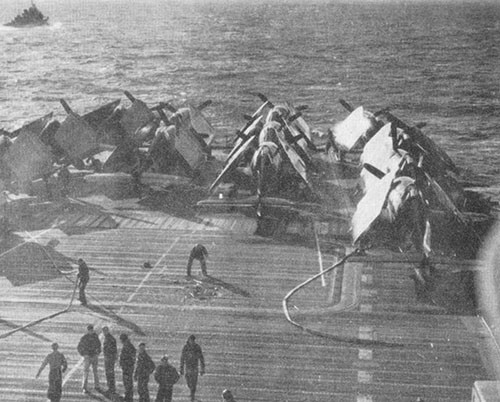
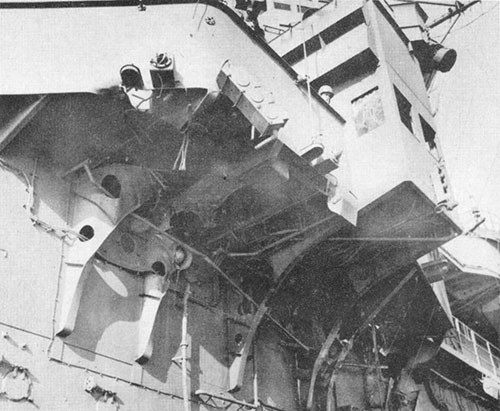
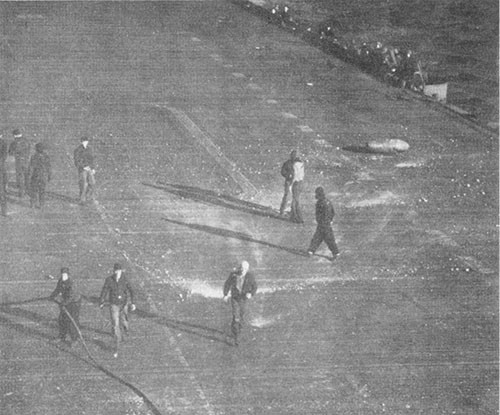
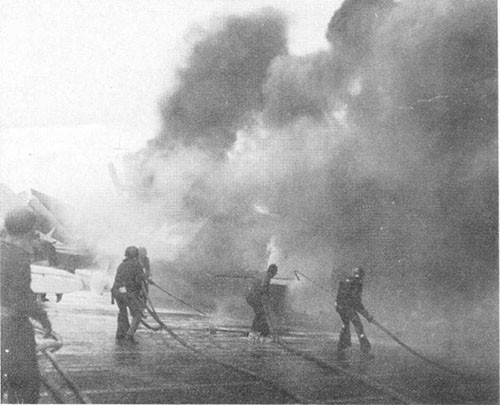
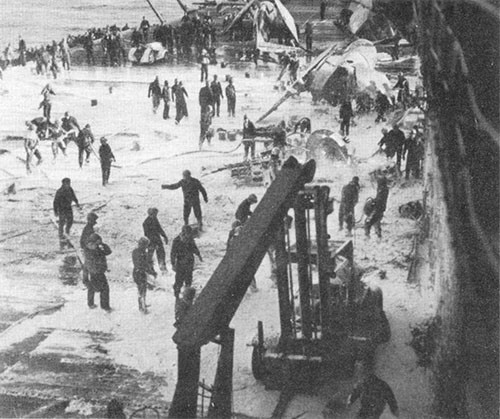
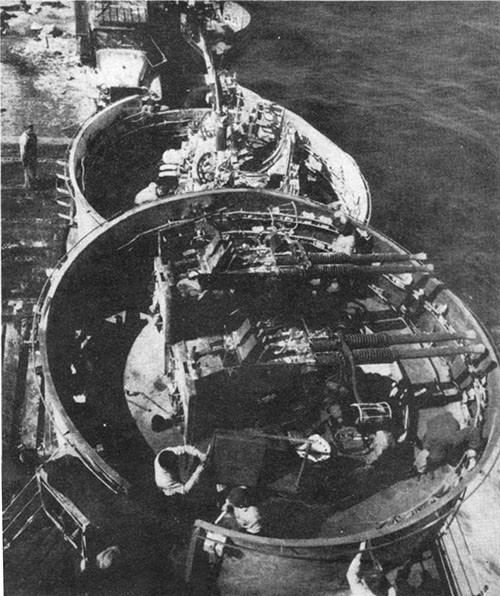
BOMB DAMAGE
STRIKES AGAINST SOUTHERN JAPAN - 18 AND 20 MARCH 1945

1. 250 KG. DUD BOMB HIT, FRAME 32
2. 5 INCH, 38 CAL. "FRIENDLY SHELL", FRAME 60-70 STARBOARD
3. 5 INCH, 38 CAL. "FRIENDLY SHELL", FRAME 34 PORT
H1-1. Shortly before operations started against Okinawa Gunto, the fast carrier force which had supported the landings on Iwo Jima was sent north to continue strikes against the Japanese home islands. Its mission was to provide a powerful shield between Japan and Okinawa which could prevent large-scale Japanese Fleet action against the U.S. amphibious operations, to bombard and bomb strategic shore installations and to seek out and destroy the remnants of the Japanese Fleet.
H1-2. ENTERPRISE departed Ulithi on 14 March as a unit of a night carrier task group. Her primary mission was to furnish night combat air patrol for the task force which struck airfields, factories and ships in the Kyushu, Shikoku and southern Honshu area during the three-day period 18-20 March.
H1-3. On 18 March, the task group operating to the southeast of Kyushu was subjected to sporadic attacks by single Japanese planes. At 0735 a JUDY was sighted on the port bow at a distance of 10,000 yards and an altitude of about 150 feet. Although taken under fire, the plane flew head on toward ENTERPRISE and dropped a 250 Kg bomb which ricocheted off the forward elevator, struck under the navigating bridge and fell to the deck, a dud. Five more attacks were made on the ship during the day without causing damage. The following day, ENTERPRISE was spared attack, but FRANKLIN was badly damaged by two bombs and subsequent fires.
H1-4. On 20 March, the ships were subjected to additional sporadic attacks from Japanese planes. At 1613 a JUDY dropped a bomb about 50 feet to port of frame 60 and at 1626 another plane dropped a bomb off the starboard quarter. Other ships in the vicinity had opened fire and two 5-inch 38 cal. projectiles detonated over ENTERPRISE, starting a moderately serious fire on the flight deck in way of the island and a small fire in shield ammunition at No. 6, 40mm mount. At 1652 another Japanese bomb was dropped but missed the port quarter.
H1-5. The task group retired to the southeast on the twentieth, and on 22 March, ENTERPRISE, in company with other damaged ships, returned to Ulithi for repair.
H2-1. On 18 March as described in paragraph H1-3, a bomb was released almost horizontally from masthead height, struck the forward elevator at frame 32 about 7 feet to starboard of the centerline, ricocheted aft and struck the island structure just below the port side of the navigating bridge at frame 72 (Photos H-1 and H-2). It passed through seven brackets supporting the navigating bridge and primary fly control, tumbling as it went, and broke into two parts. The small tail cone fell to the flight deck, immediately below the navigating bridge and the main portion came to rest farther aft on the flight deck without detonating. Some picric acid was strewn over severed electric cables under the navigating bridge and ignited by short circuits, causing a small fire. Picric acid was also scattered over the flight deck from frame 74 to frame 125, but did not ignite (Photo H-3). The bomb was pushed overboard soon after it hit.
H2-2. Planking on No. 1 elevator was crushed and broken in way of the initial impact over an area roughly 10 feet by 6 feet, the aluminum deck beneath was ruptured and one longitudinal was sheared at frame 34 so that the elevator sagged about 12 inches. Electric cables running along the port side of the island structure to primary fly control and to the alidade on the port wing of the navigating bridge were severed.
H2-3. The small fire under primary fly control was quickly extinguished and temporary repairs were made to No. 1 elevator within half an hour, permitting it to operate. Direction of air activities was shifted to secondary fly control.
H2-4. The bomb was identified as a 250 Kg, streamlined, No. 25, Mod. 2 Ordinary bomb. It corresponds approximately with the U.S. 500-pound GP bomb, but has somewhat greater penetrating ability. Although normally fitted with nose and tail fuzes, it had a plug in its nose fuze seat which partially accounts for its not detonating. The tail cone was fuzed with a B-3(a) fuze which fell out on deck without functioning.
H2-5. Throughout the war ENTERPRISE was favored by good fortune which accounts in no small measure for her survival. This was particularly true in this case, for had the bomb detonated either on impact with the forward elevator or on striking the island, severe damage would have resulted.
H3-1. On 20 March, as stated in paragraph H1-4, three bombs detonated in the water not far from the ship; one about 150 feet to port of frame 60 and two off the port and starboard quarters, 50 to 100 feet away. These were visually identified as the 250 Kg streamlined Ordinary type. Shock
cracked 2-inch tubing in the relief and replenishing line to the expansion tank of the starboard steering unit and a brazed joint between the flange and shell of a 12-inch copper auxiliary exhaust pipe in the after engine-room. No other damage was reported. Steering was shifted to the port unit until repairs could be effected during the night.
H3-2. During the bombing attack, a 5-inch, 38 cal. projectile, fired by another U.S. ship in the task group, detonated over 40mm mounts Nos. 5 and 7 between frames 60 and 70 on the starboard side of the flight deck. Almost simultaneously a second 5-inch, 38 cal. projectile detonated off the port bow starting a small fire in the ammunition on the shield of 40mm mount No. 6. This fire was quickly extinguished.
H3-3. Shell fragments from the first detonation pierced the belly gasoline tanks of two F6F planes spotted in the vicinity of the hit, igniting gasoline which spread over the flight deck between frames 60 and 75. The burning gasoline ignited two additional planes and initiated the explosive burning of 40mm ready-service ammunition stowed on the shields of Nos. 5 and 7 40mm mounts and .50 cal. plane ammunition piled on the flight deck just forward of the island.
H3-4. Primary fly control, the main communication office, radio central and CIC were made untenable by heat and smoke and abandoned via descending lines previously attached to the navigating bridge. The navigating bridge, however, remained habitable and the ship's course was altered to take advantage of the wind to clear smoke and heat to port away from the island.
H3-5. As a result of the fire, Nos. 5 and 7 40mm mounts and the Mk. 51 director for No. 5 mount were burned out (Photo H-6). Primary fly control was gutted and the port signal bridge facilities were destroyed or put out of commission. Electrical, radio and IC systems in the pilothouse, main communications office and Radio I were burned out or grounded by water. Flight deck planking was destroyed in the area between frames 65 and 75 on the starboard side; and the expansion joint cover at frame 70, the armored hatch of the forward bomb elevator and the palisades at frame 64 were also damaged.
H3-6. Although hampered by exploding ammunition, flying fragments and continued dive bombing attacks, repair parties attacked the fire vigorously, cooling and smothering it with fog and mechanical foam so that after 35 minutes all but a few persistent blazes, apparently burning magnesium airplane wheels, were smothered beneath the foam blanket. Electrical fires in the island structure persisted somewhat longer, but all fires were out 50 minutes after the hit.
H3-7. While the fire raged on the flight deck, measures were taken to prevent its effects from spreading to other parts of the ship. Ready-service 40mm ammunition in A-0301-M was sprinkled, hose streams were played on the overhead of the hangar deck beneath the conflagration and the after water curtain of the forward bay was turned on to segregate planes aft. A small fire developed in the bottom of the forward bomb elevator well, fed by gasoline which leaked around the damaged elevator
hatch. Although the elevator trunk bulkheads in way of the third deck were heated, the fire burned itself out without causing damage.
H3-8. Watertight integrity for the most part was good, preventing all but a small quantity of the tons of water poured on the flight and hangar decks from penetrating the hull below the hangar deck. Some gasoline and water leaked down the after bomb elevator without igniting and gasoline and water also backed up into crew's head D-203-2L and sick bay bath D-302-3L through weather deck and below deck drainage which interconnected at the same valve on the fourth deck. There was no measurable reduction in buoyancy or stability.
H3-9. Fire-resistant paint and fiber glass insulation on the inside of the island plating stood up excellently to the intense heat. Although paint on the inside of dead-lights in some cases carbonized and flaked, it did not ignite, thereby preventing fire from spreading through the interior of the island.
H3-10. Burning gasoline and exploding ammunition presented the initial ingredients which in some other cases of carrier damage resulted in fatal or near fatal conflagrations. The characteristically skillful and vigorous attack made by ENTERPRISE's crew on the conflagration, however, confined it to the initial area - with the exception of the small fire in the forward bomb elevator - so that a minimum amount of damage resulted.
SUICIDE PLANE CRASHES OKINAWA, 11 APRIL 1945

1. SUICIDE PLANE & 250 KG. BOMB NEAR-MISS, FRAME 136 PORT
2. SUICIDE PLANE & 250 KG. BOMB NEAR-MISS, FRAME 30 STARBOARD
I1-1. On 24 March, ENTERPRISE anchored in Ulithi where repairs to the damage received on 18 and 20 March were undertaken by the ship's force and personnel from JASON. They were not completed in time for her to participate in the 1 April landings on Okinawa, but by 7 April she was able to join Task Group 58.3 operating near Oagari Shima, to the east of Okinawa.
I1-2. After the landings on Okinawa, the Japanese committed their last air reserves, the Kamikaze corps of suicide pilots, already used with some success at Leyte and Lingayen. Although a serious drain on Japanese manpower and aircraft production, it was the most effective aerial weapon for damaging naval targets developed by the enemy in the war, so the list of sunk and damaged U.S. vessels grew rapidly.
I1-3. A large-scale Kamikaze attack developed against Task Group 58.3 on 11 April northeast of Okinawa. At 1345 two large groups of Japanese aircraft were noted closing from the north. ENTERPRISE opened fire on two planes at 1408, shooting one down about 1500 yards off the starboard quarter. While ENTERPRISE was in a port turn, the other dived on the port quarter, struck and carried away the sponsons of 40mm mounts Nos. 8 and 10, and fell into the sea. The engine of the plane glanced off the ship's side at the waterline, denting and opening the blister at frame 136. The bomb carried by the plane detonated beneath the ship at approximately frame 134 lifting the ship bodily and whipping it violently. Eight fuel tanks and two voids were ruptured. Pedestals of spring bearings for Nos. 3 and 4 shafts, after pedestals of Nos. 3 and 4 turbo-generators, SK radar and the forward master gyro compass were damaged by shock. The damaged generators had to be secured, so that split operation of the electric plant could not be continued.
I1-4. At 1500 another Japanese plane carrying a bomb, attempted a suicide dive but missed and struck the water 45 to 50 feet off the starboard bow opposite frame 30 where the bomb detonated causing additional shock damage and slight structural damage in six tanks and voids. Water spray carried as far aft as the pilothouse and part of the
plane wing was hurled to the flight deck. A fighter plane on the starboard catapult was ignited and fire spread to the deck. Since shock failure of the forward Diesel fire pump hampered firefighting, the plane was catapulted into the sea. The small fire on deck was quickly extinguished.
I1-5. During the afternoon, five more enemy planes were shot down near ENTERPRISE. After dark the Japanese dropped flares, but no attacks developed. A torpedo plane, returning from a night intruder mission, made a crash landing. It destroyed four night fighter aircraft and started a fire which was quickly extinguished.
I2-1. The outboard gun shields and semicircular platforms of 40mm mounts Nos. 8 and 10 were sheared off or bent by impact of the plane and blast from the first near-miss (Photo I-1). Parts of the plane remained in the gun tubs. Distortion of the shield of mount No. 8 blocked the train of the gun until damage control parties removed the obstruction. The guns and mount were undamaged.
I2-2. The plane's engine struck the blister at frame 136, tearing a 3-foot by 2-foot hole into D-54-F at the waterline (Photo I-2). No other holes were opened in the welded blister plating, although it was dished in between frames 134 and 138 by the bomb detonation.
I2-3. Tanks D-4-F and D-12-F were opened to D-54-F by failure of about 100 rivets along the seam just below the armor, (Photo I-3), and to each other through a 2-inch crack in a seam of bulkhead 134 which was badly wrinkled. Swash plates and floors, frames 132 through 137, were crumpled, bulkhead 138 was slightly buckled and No. 2 torpedo bulkhead between tanks D-4-F and D-12-F and tank D-6-F was deflected but not opened. The original shell plating at the bottom of D-6-F was dished in and a riveted seam opened. Tanks C-34-V, D-2-V and D-10-F, between torpedo bulkheads 4 and 5, were opened to the sea through leaky seams in the shell. Deformation of bulkheads and stiffeners occurred as far inboard as the port bulkhead of after generator room, D-5-E. No panting of damaged structure developed.
I2-4. Violent whipping of the foremast induced by the flexural vibration of the ship broke the struts supporting the SK radar antenna and snapped off about 6 feet of the starboard yardarm. The yardarm was cleared and an unsuccessful attempt was made to install a temporary support for the antenna.
I2-5. The second near-miss slightly buckled floors, frames and bulkheads in tanks A-901-V, A-7-V, A-11-V, A-17-V, A-23-V and A-15-W. Slight leaks developed through shell seams and rivets into A-901-V, A-7-V and A-17-V and through bulkhead 35 between A-15-W and A-11-V.
I3-1. Shock and structural deformation between frames 120 and 150 in way of the first near-miss forced foundations of Nos. 3 and 4 main generators, Nos. 3 and 4 main engines and Nos. 3 and 4 shaft spring bearings inward and upward with a maximum permanent deflection of about one inch.
I3-2. Both generators were broken loose from their foundations at the after ends of the turbines. The turbines were thrown upward four to five inches. The supporting pedestals broke away from the cast iron exhaust casings of which they were a part (Photo I-4), leaving the ends of the turbines with no support. In addition, the governor relay housing of No. 4 generator broke (Photo I-5), fixed and moving rows of blading were bent at the edges, and bull gear, pinion and turbine bearings and bull gear and pinion thrust bearings were wiped. Also, the forward bull gear bearing of No. 3 generator was wiped. Further damage was prevented by lifting the ends of the turbines on hydraulic jacks.
I3-3. No. 4 generator, which was carrying the load aft under split plant operation, tripped out. An attempt was made to carry the load on No. 3 generator in order to maintain split plant operation, but after two hours running, vibration became excessive and it was secured. The ship was then dependent on Nos. 1 and 2 main generators and the emergency Diesel generators. It should be noted that the after emergency generator started instantly and automatically when No. 4 main generator tripped out.
I3-4. No. 4 shaft was slightly bent, the bow in the shaft causing its Nos. 2 and 3 spring bearings to wobble athwartships about one inch with each revolution. In addition, the horizontal top plate of the foundation for No. 3 spring bearing was torn from the vertical plates, one foot supporting the shell of No. 2 spring bearing was broken and No. 1 spring bearing was moved slightly out of alignment.
I3-5. There was no damage to No. 4 main engine, although all three bearings of the H.P. pinion and the center bearing of the L.P. pinion were wiped and burned. The after end of the L.P. pinion was slightly out of alignment but the bearing was not wiped. This damage apparently did not prevent the reduction gears from functioning normally.
I3-6. Although bent less than the outboard shaft, No. 3 shaft suffered more damage to its supports. No. 1 spring bearing, closest to the detonation, had three shim chocks on the outboard side and the foot and one shim chock on the inboard side fractured in compression
(Photos I-6, I-7). No. 2 spring bearing was broken in a similar way and in addition had a crack in the bearing shell which permitted oil to leak from the sump. Two shim chocks each were broken at No. 3 and No. 4 spring bearings.
I3-7. Damage to No. 3 main engine was appreciable, though not disabling. The bearing pedestal at the after end of the H.P. turbine was lifted 1/16 inch clear of the shim chocks on the inboard side and the foot of the pedestal was cracked by the compressive load on the outboard side (Photo I-8). Two chocks were broken under the outboard side of the L.P. turbine. The after bearing of the L.P. turbine, the forward and after bearings of the H.P. turbine and all three bearings of both H.P. and L.P. pinions were wiped. The reduction gear teeth were not damaged, but misalignment in the gears caused intense vibration at high speeds and during turns.
I3-8. Nos. 3 and 4 ship's service AC-DC motor-generators were displaced by the shock. Deformation was generally elastic, however, with permanent distortion only in the foundation bolts which had to be tightened one half turn. No. 4 motor-generator was temporarily disabled by a short circuit in its starting panel (Photo I-9). Although it was not running at the time, the motor line switch was in the closed position and the motor line contactor was closed momentarily by shock and then reopened, causing a flash which carbonized the ebony asbestos panel on which the contactor was mounted, so reducing the resistance between phases of the contactor that the motor-generator could not be restarted. The ship's force repaired this temporarily. In addition, bakelite strips supporting control circuits in the switchboard were cracked and two voltmeters and a synchroscope were shattered.
I3-9. The general flexural vibration splashed some mercury from the bowls of both gyro compasses across electrical connections. The forward compass was disabled but was restored to service within a few hours. The after gyro compass continued to function.
I3-10. Miscellaneous shock damage occurred as follows:
(i) The after surge tank leaked slightly through a small crack in the shell.
(ii) The base of a 14-inch lathe in the general machine shop was broken.
(iii) Numerous thermometers and gauges in compartments between frames 120 and 150 were broken.
(iv) There were several piping failures in salt water, fuel oil and drain lines.
(v) No. 2 36-inch searchlight was hit by fragments and damaged by shock. Lens and instruments were broken.
I3-11. The SK radar was inoperable because of the broken supporting struts for the antenna on the foremast.
I3-12. Blast ruptured the main drain line of the external gasoline system between frames 141 and 152 beneath the 40mm mounts. The system was secured at a cut-off valve forward of the break.
I3-13. The most serious machinery damage resulting from the near-miss forward was the disablement of No. 1 Diesel fire pump in A-9-E. Shock opened its piping connections, distorted the foundation and broke the timing gear housing. Repairs were beyond the capacity of the ship's force.
I3-14. A minor leak occurred in the inner wall of the double-walled gasoline system drain line in way of the gasoline trunk as a result of the second near-miss.
I4-1. The three tanks between torpedo bulkheads 4 and 5, D-10-F, D-2-V and C-34-V, which were opened to the sea through weeping seams and rivets, were the only damaged tanks empty at the time. They filled slowly and caused a 1° list to port and an estimated 3-inch increase in draft aft. The tanks were pumped down through the main drainage suction.
I4-2. Fuel tanks, D-4-F, D-6-F, D-12-F and D-54-F were full so that, although leaks contaminated and largely displaced the fuel, there was little appreciable effect on list or trim. Flooding from the sea was more rapid than for the inboard tanks, hence only D-6-F could be pumped down. A large oil slick trailed ENTERPRISE for about an hour.
I4-3. The drafts before damage were approximately 26 feet 10 inches forward and 28 feet 9 inches aft as read on the internal draft gauges. The draft was increased about 3 inches aft by the flooding from the first near-miss.
I5-1. Failure of the forward Diesel fire pump in A-9-E hampered efforts to extinguish the blaze on the plane spotted on the starboard catapult, since segregation of the firemain in battle condition assigned this pump to the forward starboard plugs. While cross-connection valves were being opened and hoses led from the other plugs, the burning plane was catapulted from the ship. The burning tail remained on deck and was rapidly extinguished with water and foam.
I6-1. The problem of mounting an effective attack against the growing U.S. Fleet, complicated by the improved interception of our combat air patrols, the accuracy of our ship anti-aircraft fire using the proximity fuze, a lack of thoroughly trained pilots and other
factors was solved in characteristic Japanese fashion by organizing a corps of suicide pilots, the Kamikaze, to dive explosive-laden planes directly into the target ship. Although this method was very wasteful of planes and pilots, it was extremely effective in inflicting serious damage to our ships.
I6-2. The first appearance of a deliberate suicide attack by Japanese planes was at the Battle for Leyte Gulf. ZEKE-52's, the most commonly used at first, were supplemented by many other types later on. A 250 Kg bomb was usually carried.
I6-3. The final war damage report from the Commanding Officer of ENTERPRISE, which forms a part of reference (1), made no attempt to identify the planes used in the suicide attacks other than to call them dive bombers. The action report, reference (i), stated the belief that both near-misses were by JUDY-11's. However, a photograph in reference (i) shows a head-on view just before the crash, which indicates that the plane which grazed the port quarter was a ZEKE-52, with a bomb slung under the fuselage, the type of plane and bomb position also used in the attack of 14 May. The plane which fell off the starboard bow was probably a JUDY-11, judging from the action report and from a photograph of the piece of the wing recovered on the flight deck.
I6-4. There is no way to determine the type of bomb carried in either instance. The damage sustained as a result of the detonation under the port quarter would suggest a 250 Kg streamlined Ordinary bomb. This bomb was very commonly used during the latter part of the war and was the type which fell as a dud on ENTERPRISE on 18 March and also the type carried into the ship by the suicide plane of 14 May.
I7-1. Prompt intelligent action, typical of the history of ENTERPRISE, prevented the fire in the plane on the starboard catapult from becoming serious. The manner in which the fire started is not known. The fact that part of the wing of the Japanese plane was thrown onto the flight deck suggests that hot fragments pierced and set fire to the fighter.
I7-2. Except where torn open by the impact of the plane's engine, the welded blister plating did not develop cracks or tears from the first near-miss. The structure was dished in, but remained intact. In contrast to this, rivets popped and seams opened in the original hull even where protected by the blister.
I7-3. As in the Battle of Santa Cruz, cast iron failed when subjected to shock. In the latter instance damage was much more widespread, with failure of shim chocks under spring bearings, exhaust casings of turbo-generators and the pedestal of No. 3 H.P. turbine. The low impact resistance of cast iron is well known and it is now general practice not
to use grey or white cast iron in machine parts aboard ship. Motor-generator parts, which were made of cast steel rather than cast iron, stood up very well.
I7-4. More serious perhaps than failure of the turbine, generator and bearing parts made of cast iron was the misalignment of the two port shafts. Both were bowed, the outboard one considerably, as a result of general deformation of the ship's structure in way of the detonation. This could only be prevented by design changes which would be too costly in weight as discussed in the War Damage Report on CANBERRA*. Although the engineering force experienced difficulty in keeping the bearings cool, the shafts continued to operate, a tribute to rugged design and justification of conservative factors of safety in shaft design. It is of particular interest to note that ENTERPRISE returned to the operating area in May with her shafts still bowed because the major repairs required to realign the structure were beyond the facilities of the forward area.
___________
* BuShips War Damage Report No. 54.
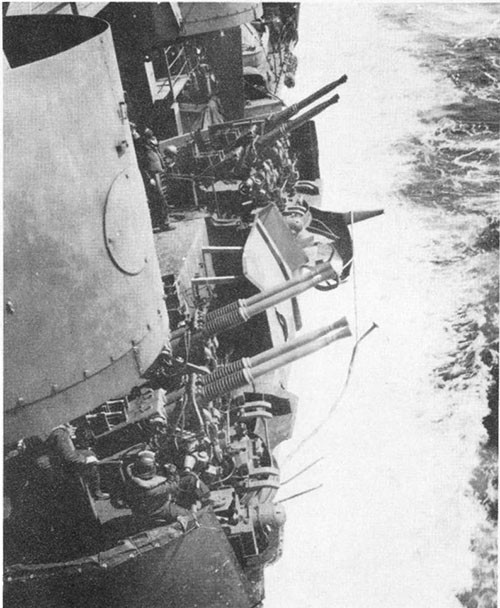
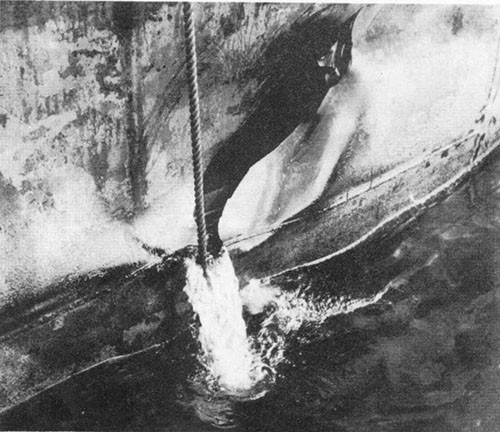
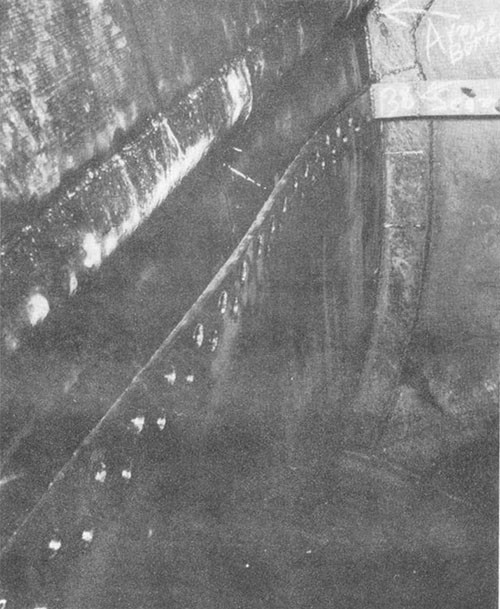
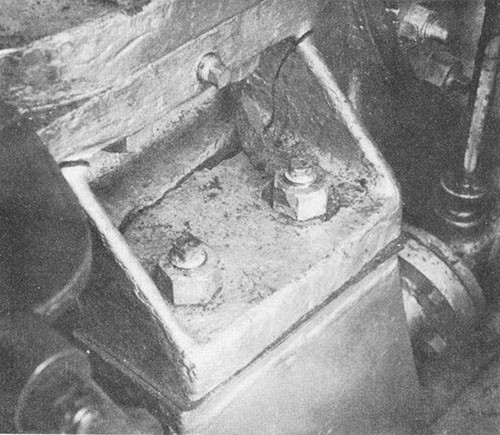
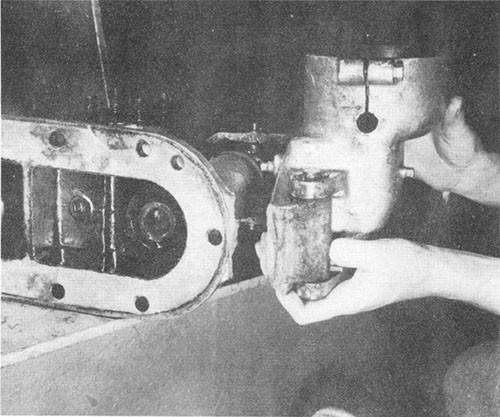
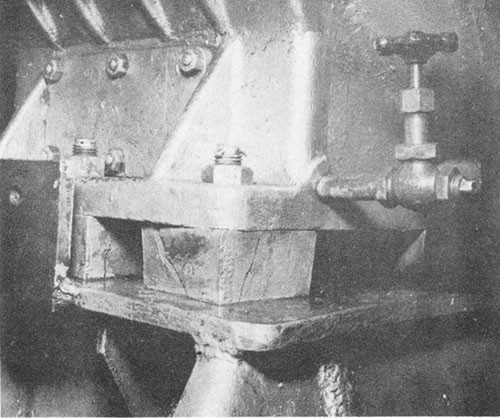
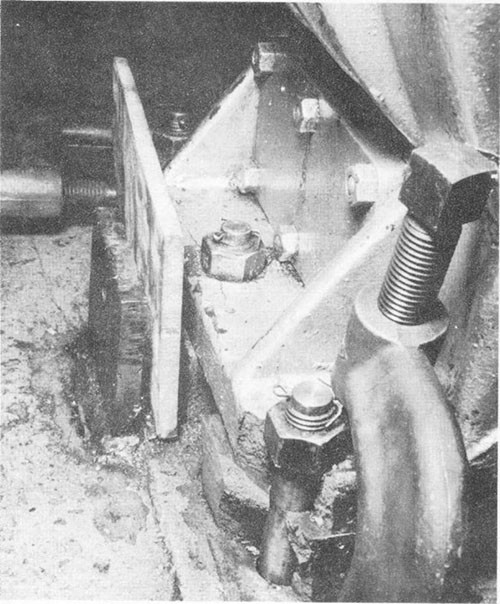
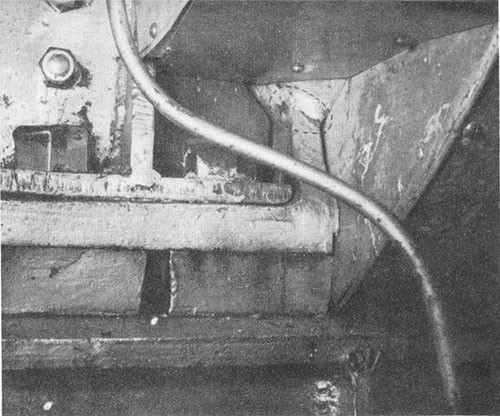
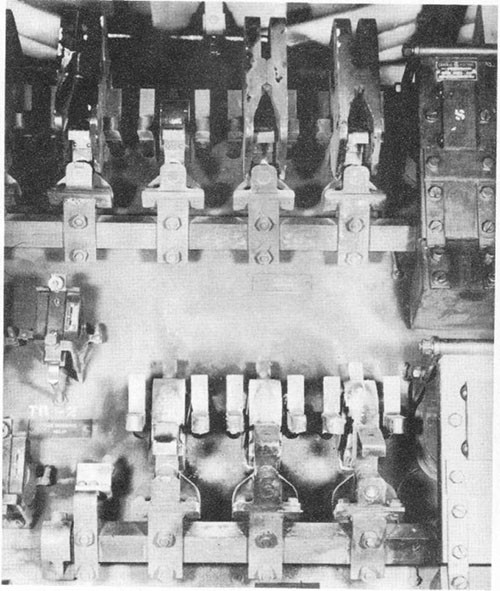
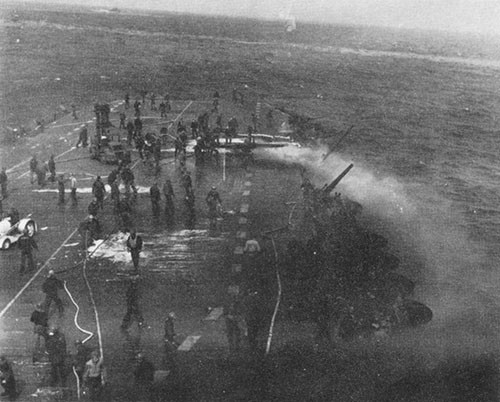
SUICIDE PLANE CRASH
KYUSHU, 14 MAY 1945

1. SUICIDE PLANE & 250KG. BOMB HIT, FRAME 42
J1-1. ENTERPRISE remained in the vicinity of Okinawa providing night combat air patrols, anti-submarine patrols, etc., until 14 April when she once again departed for Ulithi for repairs. A patch was welded over the hole at frame 136, spring bearings were realigned, and cracked cast iron feet on turbines and spring bearings were repaired with metal-lock or brazing. A 4-inch riser to the firemain was connected from one of the two steam centrifugal pumps which had been installed but not connected in the summer of 1943. By 3 May temporary repairs were completed and she departed Ulithi, rejoining Task Group 58.3 on 6 May off Okinawa.
J1-2. The next six days were spent northeast of Okinawa providing night and twilight combat air patrols, target combat air patrols and night heckler flights over the northern Ryukyus and the airfields of southern Kyushu.
J1-3. On the night of 13-14 May, the task group was southeast of Kyushu, launching strikes against Japanese airfields. At 0357, ENTERPRISE went to General Quarters upon receipt of the report that Japanese planes were in the vicinity. It was not until 0645, however, that the combat air patrol shot down three planes. At 0653, the guns of ENTERPRISE opened fire on a plane to starboard and the ship swung hard left in an emergency turn, but to no avail. The enemy plane maneuvered in the clouds and dropped from an altitude of approximately 1500 feet in a 30° dive. Some 200 yards from the ship the pilot flipped the plane over in a left-hand snap roll to steepen the dive and struck the flight deck just abaft the forward elevator slightly to port of the centerline (Photo J-1).
J1-4. The plane, engine and bomb crashed through the deck and the engine and pieces of the plane came to rest in the forward elevator pit. The bomb penetrated the elevator pit into storeroom A-305-A below, where it detonated high order causing extensive structural damage and igniting a serious fire. The forward elevator was completely demolished and the flight deck was rendered
inoperative aft to frame 70. Fires were extinguished by 0730, but about 2000 tons of firefighting water had flooded spaces between frames 26 and 38 up to the hangar deck.
J1-5. During the attack, ENTERPRISE maintained her station in the formation and from 0758 to 0817 was actively engaged in repelling intermittent attacks by Japanese planes, of which her gunners shot down four. The remainder of the day was relatively quiet.
J2-1. The plane struck the flight deck at an angle of about 45°, just abaft the forward elevator at frame 42, slightly to port of the centerline. A hole roughly 12 feet long by 20 feet wide was punched through the flight deck (Photo J-3). After nicking the lower flange of the transverse bent at frame 40, plane and bomb separated. The bomb pierced the elevator pit (second deck) at about frame 35 just to starboard of the centerline and detonated high order below, in A-305-A on top of stowed rags (Photo J-4). The engine and pieces of the plane landed in the forward starboard corner of the elevator pit.
J2-2. A hole roughly 12 feet square was blown through the second deck and a slightly smaller one through the third deck. The forward elevator was hurled into the air, the decking pulling away from the main supporting framework. About three-quarters of the decking was raised intact on a plume of smoke about 400 feet above the ship and fell into the sea (Photo J-2). The elevator framework was turned over about a transverse axis falling upside down into the elevator pit (Photo J-5). Other parts of the elevator, the remainder of the decking, the peripheral girder and brackets for the steadying rails fell on various parts of the flight deck forward and aft of the elevator hatch. One piece struck the navigating bridge splinter shield at frame 70.
J2-3. The fourth deck in A-405-A was deflected downward by the blast and adjacent structure was damaged sufficiently to render ineffectual the watertight integrity of the following compartments: A-9-E, A-11-V. A-504-A, A-505-A, A-404-A through A-408-A, A-305-A, A-204-L, A-206-A, A-207-AT and A-208-IL. The forward bulkhead of the elevator trunk at frame 26 was deflected forward between the main and flight decks (Photo J-6). Quick-acting watertight door 1-26-1 was blown forward (Photo J-7). Three officers' heads forward of the elevator and the officers' living quarters surrounding the elevator were demolished.
J2-4. Despite the large "venting area" provided by the elevator opening in the flight deck, the effect of the blast in the hangar space was great. The flight deck bulged upward across the whole width of the ship between frames 40 and 69 (Photo J-8) with a maximum deflection of about 3 feet 6 inches at frame 46 centerline. Light, built-up, transverse girders deflected more than heavier plate bents (Photo J-9). In addition, the port end connection of the intermediate transverse flight deck girder at frame 46 parted completely and the flight
deck between frames 43 and 50 tore away along the inboard bulkhead of the gallery (Photo J-10). The blast wave continued aft blowing out or damaging hangar deck curtains back to frame 140. Evidence was noted of reflection of the blast wave downward from the flight deck to the hangar deck at frame 67 and upward to the gallery deck at frame 80 by more severe distortion of structure at these points. Buckling of the heavy centerline stanchion below the main deck at frame 67 illustrates this reflection (Photo J-11). Radio III on the gallery deck, frames 66 to 69, was severely damaged by buckling of the deck. Some structural deformation was also found on the second deck between frames 20 and 70.
J2-5. The bomb detonation was about 10 feet aft and 4 feet below a sectional steel rack in the elevator pit on which was stowed a quantity of bar stock. Although the rack was destroyed, none of the stock was dislodged as a "missile hazard." The bars, still tied together by light wire, fell to the deck.
J2-6. Detonation was just above a pile of rags, stowed 4 to 6 feet deep in A-305-A, which was effective in limiting fragment penetration below the third deck. Fragment penetration above was extensive. The bulkheads of the elevator trunk and pit were riddled by fragments, (Photo J-6), except in way of six or seven sheets of steel stowed vertically against bulkhead 38 (Photo J-5). The hull was penetrated by a few small fragments on the third and fourth decks in the vicinity of the detonation.
J2-7. Twenty helium and sixteen oxygen cylinders of the shatterproof, 200 cubic feet capacity type stowed in the elevator pit, half on each side along the longitudinal bulkheads, were subjected to fragment attack and enveloped by the ensuing fire. Two oxygen and ten helium cylinders were recovered intact. Of those which were destroyed, apparently none were shattered. Those which burst from heat tore open longitudinally and flattened out or blew off the valve top. The gas bled harmlessly through fragment holes in those which were pierced.
J2-8. Although structural damage reduced operational effectiveness by rendering the flight deck useless between frames 25 and 70, the strength of the ship's girder was little affected. The hangar deck was slightly weakened by minor deformation and the second and third decks were torn open below the elevator pit, but temporary repairs were not required and permanent repairs could not be made with the facilities on board.
J3-1. The most serious piping damage was the rupture in A-305-A of a 6-inch firemain loop and a 3-inch damage control main riser. Water flowing through these breaks was one of the principal sources of flooding. High and low pressure air lines, fresh water piping and drainage piping also were extensively damaged in the vicinity of the explosion (Photos J-12 and J-13).
J3-2. Three of the ship's four gasoline tanks developed slow leaks from the shock. The port gasoline main was crushed and unfit for use between frames 62 and 106; the starboard main was destroyed by fire and fragments between frames 26 and 38 and various risers, valves and fueling stations were destroyed. The system was estimated to be only 10 per cent operative.
J3-3. Ventilation ducts were carried away in the immediate vicinity of the detonation and considerable duct work was punctured, dented and crushed throughout the area in which blast damage to bulkheads and decks occurred. This damage was heaviest between frames 20 and 54 on the second deck and frames 18 and 41 on the main deck. The most serious damage to the ventilation system occurred when blast jammed open the closure of the Diesel pump air supply duct in A-9-E permitting fire-fighting water and water from damaged mains to flood the space. Five men were driven out of A-9-E and later trapped and drowned in A-404-A.
J3-4. Flooding of No. 1 Diesel fire pump in A-9-E was the only important machinery casualty produced by the hit. Pumps were overloaded in order to maintain 100 pounds pressure. No. 4 fire-and-bilge pump and No. 2 Diesel fire pump overheated, but did not have to be secured before the fire was under control.
J3-5. Heavy smoke from the fire reached all machinery spaces and was particularly severe in the firerooms. Personnel had to use battle lanterns in order to see water levels in the boiler gauge glasses. Key men used hose masks adapted by the ship's force from ordinary gas masks by removing the canister and fitting an air hose from the low pressure air system. Air bottles of 200 cubic feet capacity were available in the event of failure of the compressors. Other personnel used conventional gas masks to reduce the inhalation of smoke. Smoke was not so thick in the enginerooms and masks were not worn.
J3-6. The forward main and auxiliary elevators were completely destroyed by the bomb detonation and the two flight deck bomb elevators between frames 71 and 81 on the starboard side were disabled.
J3-7. Electrical damage was extensive. A total of 75,000 feet of power, lighting and communication cable was disabled by fragments and flooding forward of frame 50. Power cable for the catapults was severed on the starboard side of the second deck. Degaussing cables of the "M" coil on the third deck were severed outboard of the elevator pit and "F" coil cables were burned in the wireways under the flight deck on the 5-inch gun platforms port and starboard. All lighting forward of frame 38 was lost by the severance of main feeder cables on the second and third decks starboard side outboard of the elevator pit, and forward of frame 38 all ship service telephones, sound powered telephone communication to the guns and general alarm bells and buzzers (circuit "G") were out of service.
J3-8. Some lighting was restored by portable cables and emergency 2 to 10 KVA single phase transformers made up by the ship's force.
J3-9. The water which entered A-9-E through the supply duct flooded the secondary drain pump and both fresh water pumps in the space. Fresh water supply for the ship was regained by utilizing a boiler feed pump taking suction from a reserve feed water tank and discharging to the fresh water system through a hose connected between the pump and a shore filling connection.
J3-10. No damage was sustained by the generating plant. Although water from flooded compartments leaked through damaged cables and dripped onto bus bars of the forward distribution switchboard, the cables were disconnected from the switchboard before short circuits developed. With split plant operation, only one forward generator was running. Its main circuit breaker tripped out, but the contacts, which were lashed closed because the breaker was not shockproof, did not separate and loss of power was prevented.
J3-11. The relay panel and controllers for valves S2-39-1 and S2-39-2 of the hangar sprinkling system were damaged by shock and the cables were severed by fragments. In addition, the controllers for hangar curtains Nos. 2 and 4 were grounded by salt water.
J3-12. Almost complete loss of ventilation occurred forward of frame 50. Heater and fan panel No. 2 at frame 38 on the second deck was damaged by shock, fragments and salt water. Power panels 39 and 39S, which supply a number of vent sets in the forward area, were soaked with salt water and damaged by shock (Photo J-14), and many ventilation units and controllers were damaged by fragments, shock, fire or water. Undamaged units were reconnected to available 440 volt outlets.
J3-13. The forward elevator main pump, sump pump, thruster motors, controllers, cables and power panel were submerged in salt water. Motors and controllers for flight deck stanchions were destroyed by fire and shock (Photo J-15) and the hangar deck stanchion motor controller was destroyed by fragments and shock.
J3-14. Power to the Mk. 14 sights of 20mm batteries 1, 2 and 4 and to 5-inch Groups I and II was interrupted by the destruction of a bank of transformers mounted under the flight deck, directly in the path of the bomb and plane. 40mm mounts 1, 2, 3, 4 and 6 and their Mk. 37 directors lost power by the severance of normal and alternative power supply cables in the elevator trunk. 5-inch ammunition hoists Nos. 1, 2, 3 and 4 were disabled when two controllers in power panel No. 41 were damaged by shock and limit switches in the hoists were grounded by salt water.
J3-15. Almost all of the radio and electronic apparatus in Radio III, located in the gallery between frames 67 and 69, was destroyed by shock and blast.
J4-1. Water pouring from breaks in the fire and damage control mains and risers together with firefighting water rapidly flooded the damaged area from the hangar deck to the hold, six levels below, between frames 26 and 38, spreading through fragment holes, ducts and ruptured structure. The breaks in the mains and risers were not isolated for more than twenty minutes after the crash because smoke and fire around the elevator pit prevented discovery of the extensive damage below the second deck. By 0730, when fire and damage control mains were secured, as stated in paragraph J1-4, about 2000 tons of water had been taken aboard, centered at about frame 32.
J4-2. Drafts before damage of 26 feet 6 inches forward and 28 feet 2 inches aft increased to about 33 feet forward and 25 feet aft. The trim had little effect on maneuverability. Stability was reduced by the free surface above the second deck, but not critically. There was no list.
J4-3. Steps were taken to reduce the flooding as soon as firefighting was secured. Electric submersible pumps were lowered into the elevator pit and two P-500 gasoline-driven pumps were put into action. Free surface water in the officers' country on the second deck was eliminated through deck drains and commode drains in the heads. Pumping was severely hampered by the fouling of the pump strainers by small pieces of rags and toilet paper. It took 36 hours to remove the 2000 tons of flood water.
J5-1. As a night carrier, ENTERPRISE had no planes armed or fueled at the time of the crash and bomb detonation. Planes were parked closely in the forward end of the hangar, however, and four which had just landed were not completely defueled.
J5-2. As pieces of the enemy plane and the engine crashed into the elevator pit, flames about ten feet high flared up, evidently from the plane's gasoline. Fragments and flash from the detonation of the bomb set fire to the engines and tanks of the planes spotted forward on the hangar deck.
J5-3. The forward bay of the hangar sprinkling system from the elevator to frame 70 was turned on at once by hangar control but pressure was not immediately available on the forward starboard fire plugs. However, ample pressure on the port plugs enabled repair parties to attack the fire promptly. Hose streams were directed from the flight deck as well as from the hangar (Photo J-16). Within a few minutes, pressure was available on the starboard side forward. Hangar deck, plane and elevator pit fires were brought under control in 15 minutes and were completely extinguished in 30. No foam was used.
J5-4. Small, stubborn fires developed below decks in officers' clothing and bedding from fragments and short circuits. Although
not in themselves dangerous, they generated a great deal of smoke which endangered the ship by marking her as a cripple and by making firefighting and rescue work difficult. Rescue breathing apparatus and gas masks were used effectively. In one compartment, A-208-IL, smoke became so thick that investigation was impossible. The fixed fog system in this compartment was connected to the firemain and turned on for five minutes extinguishing most of the fires in that space and permitting personnel to enter.
J5-5. Fragments caused a severe electric and powder fire in Group I 5-inch guns on the starboard side of the gallery deck flanking the elevator, and a small fire in Group II 5-inch guns opposite. The fire in the port group was quickly extinguished by installed sprinklers and hose streams. No ammunition detonated. Water to fight the starboard fire was not available until extra hose lines were run from the port side and from the starboard fire plug at frame 69. Some 5-inch ready-service powder burned without injury to personnel. This fire was extinguished at about the same time as the fire on the hangar deck (Photos J-16 and J-17). Gun crews and repair party personnel threw over the side ammunition which had been heated.
J6-1. Photograph J-1 permits accurate identification of the plane which dived on ENTERPRISE as a ZEKE-52. The bomb can also be seen in the photograph and its rounded shape strongly supports the belief that it was a 250 Kg streamlined Ordinary bomb which was in common use. The extent of damage was consistent with this type. Fragments of the bomb were recovered, but the bomb disposal officer was killed so the fragments were not positively identified.
J7-1. ENTERPRISE repair parties performed excellently and prevented serious fires from developing into a general conflagration. Everyone had been at General Quarters for three hours before the crash and was ready for any eventuality. The damage sustained during the previous two months, combined with realistic battle drills which were conducted regularly even in forward areas, had trained the crew to a point where each man knew exactly what to do. The clue to successful firefighting was found to be immediate action.
J7-2. ENTERPRISE was a night carrier and as such all her planes were normally secured in the daytime and the ship was then in the best material condition for receiving damage. Gasoline lines were drained and the bomb magazines securely closed. The aircraft which had been out at dawn had been landed and all but four drained of gasoline. Only two planes remained on the flight deck. In addition, the Japanese plane was almost out of fuel when it crashed.
J7-3. Rescue breathing apparatus, type A-1, proved of great value in firefighting and rescue work and gas masks were satisfactory against smoke for short periods where the oxygen supply was sufficient. The ship reported that sealed beam lights and battle lanterns were invaluable for penetrating smoke-filled compartments.* Flash-proof clothing provided excellent and complete protection from severe flash. Rigid stretchers were found to be impractical for transporting wounded through tortuous passages.
J7-4. Some of the flooding and probably the drowning of 5 men might have been prevented had the ventilation duct closure in A-9-E withstood the blast of the detonation. Flooding from broken fire and damage control mains could have been reduced if knowledge of the breaks had been ascertained sooner.
J7-5. Thirty-six hours were required to pump out water which was pumped aboard in one-half hour. Strainers of portable electric submersible pumps were constantly clogged by debris, scuppers through which the water should have drained off the third deck became blocked in the same way and the secondary drainage pump in A-9-E could not be used.
J7-6. The experience of ENTERPRISE in this case illustrates the ineffectiveness of "venting" the detonation of a medium or large bomb. The forward elevator was blown clear of the ship, opening an area of about 2000 square feet; the large volume of the hangar space was available and the two hangar curtains just abaft the elevator hatch provided 1200 square feet more of opening. Yet, a large section of the flight deck was forced upward and rendered useless.
J7-7. At the time of this hit, ENTERPRISE was Vice Admiral Mitscher's flagship. His comment was:
"The performance of duty of the officers and men on the ENTERPRISE under fire and their effective damage control measures were outstanding, of the highest order and the most effective that I have seen during one year's service in (Task Force 58). I was particularly impressed with the attitude of the ship's company in combatting fire when under fire; your ship is indicative of the high order of efficiency that is rapidly winning the war."
__________
* BuShips War Damage Report No. 56 - FRANKLIN.
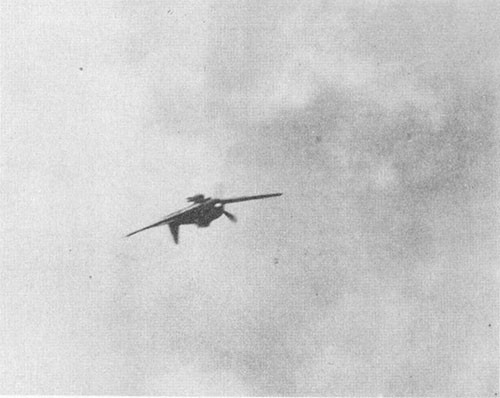
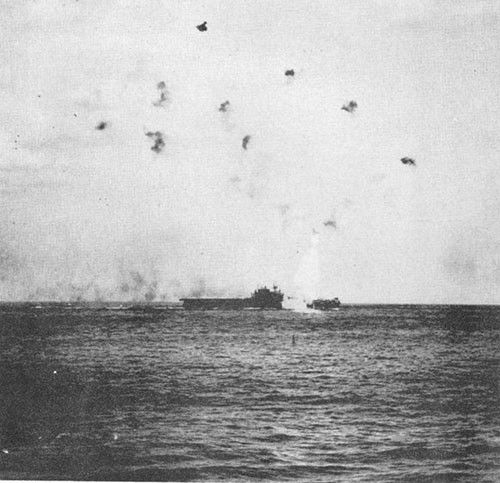
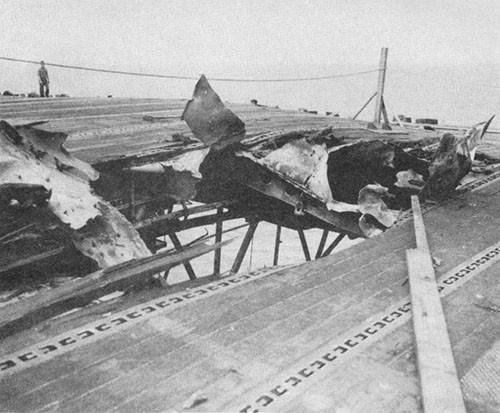
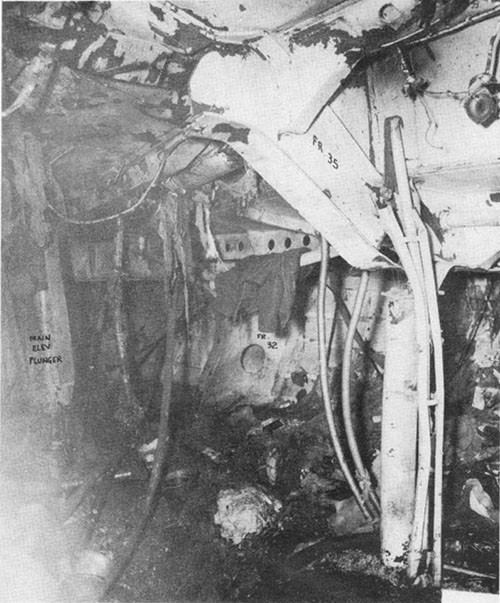
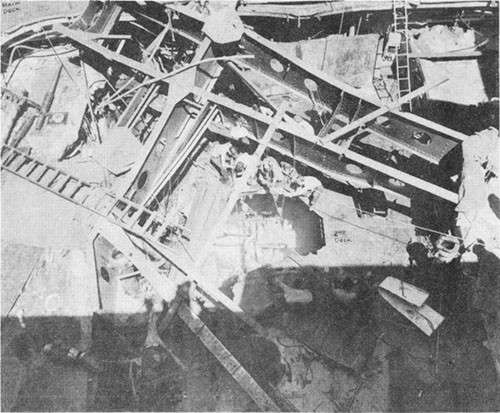
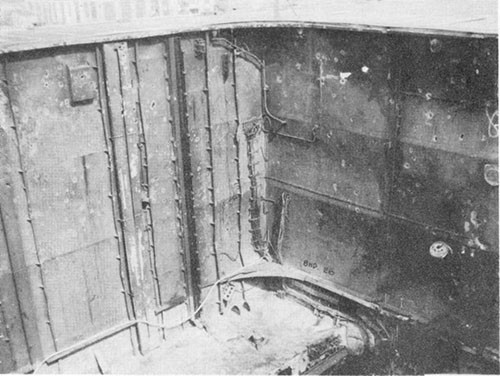
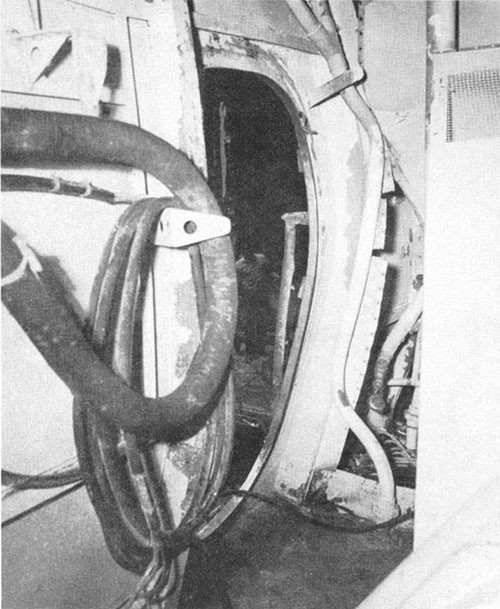
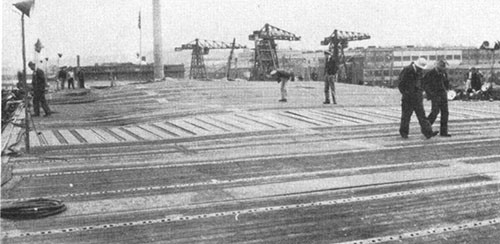
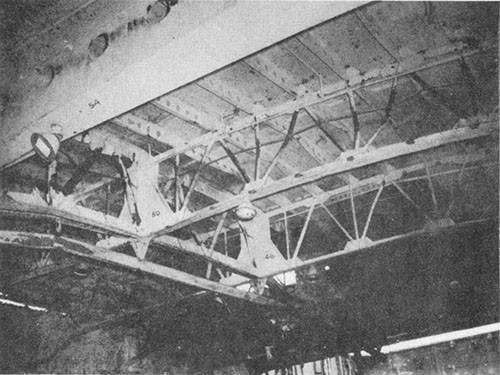
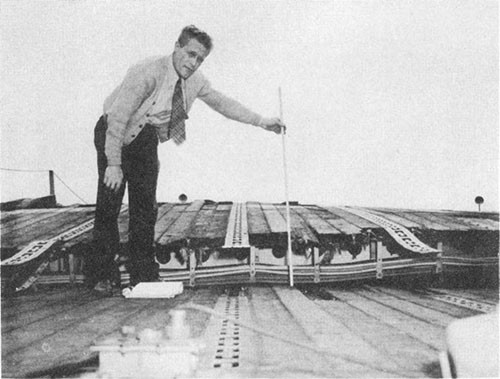
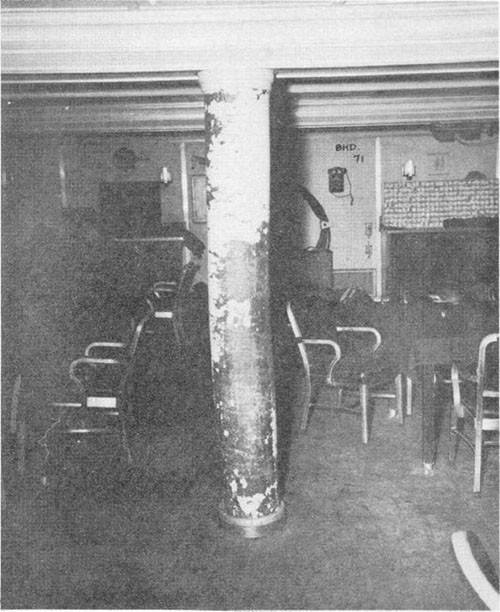
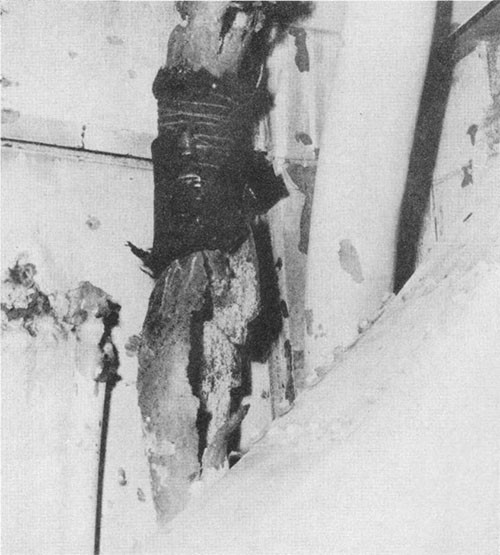
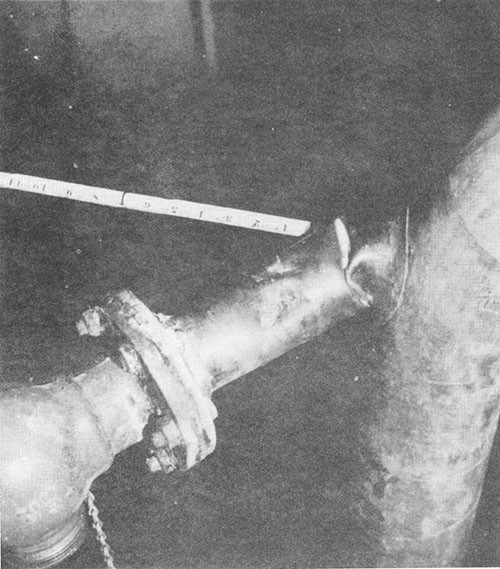
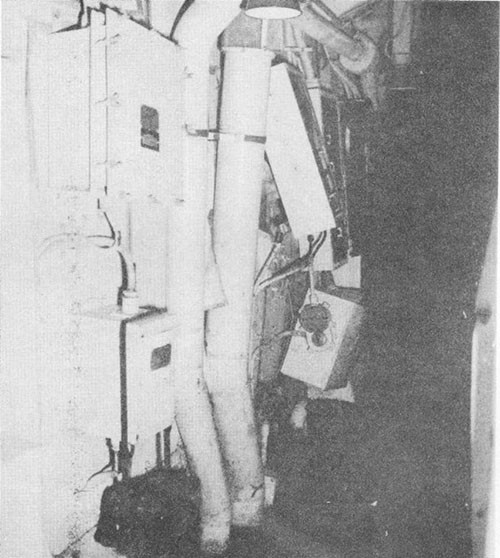
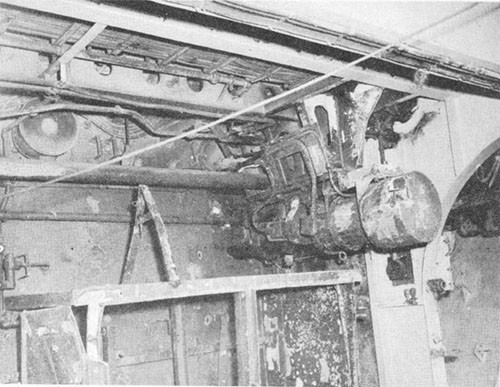
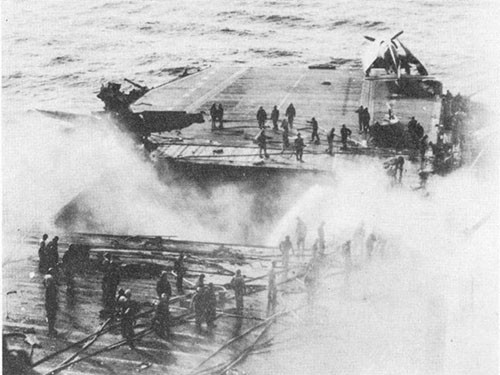
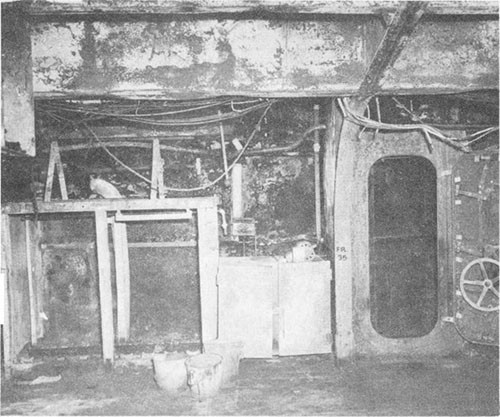
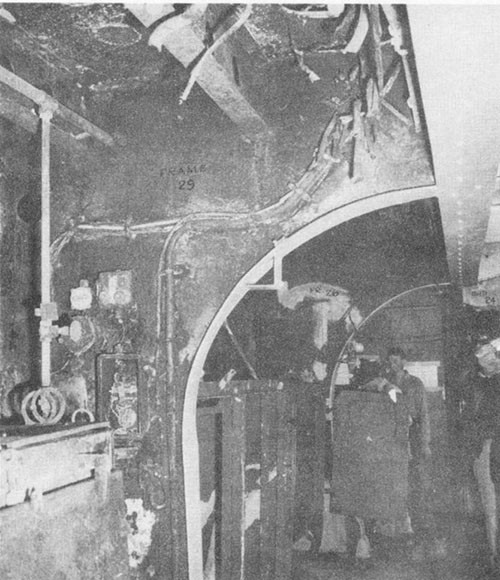
EXIT ENTERPRISE
1. Repairs
K1-1. On 15 May, the night carrier task group off Okinawa, somewhat battered by the Japanese air attacks of the day before, retired to the south to fuel. In view of the serious reduction in her operating efficiency, ENTERPRISE was sent to Puget Sound, via Ulithi and Pearl Harbor, for repairs. She arrived in Bremerton for a two months' overhaul on 7 June.
K1-2. Despite furious attacks by fanatical suicide pilots which sank or rendered inoperative many ships, including ENTERPRISE, the Japanese high command failed to prevent the defeat of the Imperial Forces. Surrender of the enemy occurred on 15 August 1945 while ENTERPRISE was still under repair in Puget Sound. She was, therefore, denied the pleasure of entering Tokyo Bay and witnessing the signing of the final surrender documents.
K2-1. Repairs and alterations, including removal of sponsons to permit passage through the Panama Canal, were completed on 12 September. ENTERPRISE then proceeded south to Alameda, California, where she picked up 878 enlisted men and officers for transport to Pearl Harbor. She arrived at Pearl Harbor on 23 September.
K2-2. In order to assist the speedy return of our citizen army to civilian life, the Navy made available a number of its combatant ships, with their superior speeds, as a "magic carpet" between the advanced bases and home. On ENTERPRISE's first trip as a part of the carpet, she carried 1141 officers and men from Pearl Harbor to New York via the Panama Canal.
K2-3. After a refit at Boston to provide additional berthing space, she made two magic carpet trips to Southampton, and then one last trip to the Azores to pick up passengers rescued from the ATHOS II and the HOOD. In January 1946, she tied up at Bayonne, New Jersey, awaiting decision as to her permanent berth.
K3-1. As a tribute to her unsurpassed war record, ENTERPRISE was chosen for retention as a National Memorial in the company of such ships as CONSTITUTION. On 1 November 1945, the President of the United States approved the recommendation made by the Secretary of the Navy that "---ENTERPRISE should be retained permanently at some proper place as a visible symbol of American valor and tenacity in war and of our will to fight all enemies who assail us?"
SUMMARY AND CONCLUSION
1. Summary
L1-1. ENTERPRISE was damaged in six different engagements by a total of six bomb hits, six damaging near-misses, one dud bomb hit and two "friendly" shell hits. Her experience is indicative of the importance of the bomb as a weapon against aircraft carriers and is confirmed by the record of U.S. carriers damaged or sunk in World War II. Out of a total of sixty-seven cases of carrier damage or loss, fifty-two were caused by bombs or Kamikaze suicide planes. The balance of the damage or loss was caused by submarine and aircraft torpedoes except for damage to three escort carriers and loss of one escort carrier by shell fire. The 62.8 Kg Ordinary, 250 Kg Land, 250 Kg Ordinary and 250 Kg streamlined Ordinary type bombs were identified as having been used against ENTERPRISE. In the last two actions, bombs were carried into her by Kamikaze planes presaging the advent of pilotless aircraft and guided missiles as primary weapons against ships.
L1-2. Although extensive structural damage was incurred on 24 August 1942, 26 October 1942 and 14 May 1945, the strength of the ship girder was never seriously affected. Nos. 2 and 3 elevators were rendered inoperative by bomb damage on 24 August and 26 October 1942, but were locked in the up position at the time damage was incurred. This permitted continuation of flight operations with only slightly reduced efficiency after completion of temporary repairs to the flight deck. The bomb explosion of 14 May, however, demolished No. 1 elevator and damaged the flight deck forward so extensively that ENTERPRISE could not continue flight operations.
L1-3. As previously noted, the only carriers to be attacked by shell fire during the war were unarmored CVE's. The side belt armor of ENTERPRISE was not attacked at any time.
L1-4. Engineering casualties were numerous, but fortunately of a relatively minor nature. Shock damage from near-misses on 26 October 1942 and 11 April 1945 resulted in the most serious derangements incurred by the machinery. Cast iron parts of No. 2 main engine were fractured on 26 October and cast iron parts of steady bearings for Nos. 3 and 4 propeller shafts, parts of No. 3 main engine and Nos. 3 and 4 main generators were fractured on 11 April. Elimination of cast iron from machine parts aboard ship will preclude the recurrence of similar casualties. Nos. 3 and 4 propeller shafts were bowed by shock derangement of supporting structure on 11 April. Similar cases are fully discussed in war damage reports on CANBERRA (CA70)* and HOUSTON (CL81)**.
___________
* BuShips War Damage Report No. 54.
**BuShips War Damage Report No. 53.
Numerous instances of shock damage to electric switchboards, motor controller panels and electronic equipment illustrated the need for continued efforts to improve the ability of equipment to withstand shock.
L1-5. The desirability of segregating duplicate systems was demonstrated by the loss of steering control after firefighting water stopped the starboard steering motor on 24 August 1942. Personnel on watch were overcome by heat exhaustion before they could start the port steering motor which was located in the same compartment and steering control was lost for 38 minutes. Similarly, all potable water pumping capacity was lost when duplicate fresh water pumps, both located in elevator machinery and pump room A-9-E, were stopped by flooding of the pump room on 26 October 1942 and again on 14 May 1945.
L1-6. Piping, ventilation and electrical systems were ruptured or destroyed in many places in way of bomb detonations. Prompt segregation of firemains, however, maintained firefighting efficiency; emergency ventilation equipment restored essential ventilation; and casualty power lines supplied vital power requirements.
L1-7. Flooding for the most part was confined to tanks and nonessential compartments and control of flooding was prompt so that reserve buoyancy and stability were never seriously reduced. The cofferdam built in storerooms D-521-A and D-419-3A on 24 August 1942 was a major undertaking and proved very effective. On 26 October when elevator machinery and pump room A-9-E was flooded through ruptured piping and overflow pipes from flooded fresh water pipes, and again on 14 May 1945 when A-9-E was flooded by firefighting water pouring through a faulty ventilation duct cover, the use of No. 1 Diesel fire pump was lost. This hindered the attack on fires in the forward section of the ship until connections could be made to pumps aft. The flow of firefighting water and water from ruptured firemains to lower compartments of the ship through damaged structure and ventilation ducts and through faulty ventilation closures was particularly serious on 14 May when some 2000 tons of flood water were taken aboard in this way. Continual clogging of strainers hampered efforts to remove flood water on every occasion of flooding.
L1-8. Although fires resulted from bomb detonations in each of the six actions, the ship's preparedness and the prompt and intelligent attacks made upon the conflagrations prevented any from getting out of control. The vigorous program of scraping paint from all interior surfaces and substituting one thin coat of fire retardant paint, the removal of overstuffed furniture and non-essential papers, files, etc. and the stowage of all but a week's supply of inflammable stores in compartments below the waterline, together with the fact that planes for the most part were degassed and munitions were stowed in the magazines at the time of the attacks, reduced exposed combustible material to a minimum, thus greatly limiting the severity of conflagrations. The hangar sprinkling system was very effective in limiting the spread of the fires of 20 March and 14 May 1945 and mechanical foam rapidly extinguished the gasoline fires of 20 March and 11 April 1945.
L2-1. ENTERPRISE was fortunate in that no bombs penetrated to her magazines, gasoline tanks, main machinery or other vital spaces. Her planes were secured and defueled, with bombs, torpedoes and plane ammunition stowed in magazines at the time bomb hits were scored. A policy of keeping personnel at General Quarters when there was danger of enemy attack was maintained so that they were not caught unprepared. As many fire hazards as possible were eliminated and Material Condition ABLE was maintained when in dangerous areas, assuring that the ship would be in the best possible condition to resist damage. Finally, constant damage control drill and study of lessons learned by other ships so developed the crew's skill that each man knew his duties and carried them out without hesitation, thus producing the immediate action which is the fundamental clue to successful firefighting.
L2-2. Failure of cast iron machinery parts when subjected to shock clearly illustrates the grave potential danger of substituting cast iron for cast steel or steel weldments in machinery components. Deviations from machinery specifications which require cast steel or steel weldments for machinery components therefore should be undertaken only in the event of severe procurement difficulties.
L2-3. Flooding of the duplicate steering motors and duplicate fresh water pumps indicates the undesirability of locating duplicate units in the same compartment. Although such an arrangement provides adequate protection against the failure of one unit during peacetime operations, war inflicted casualties will generally affect both units unless they are separated at least by a watertight bulkhead.
